Jessica Knauss's Blog, page 5
April 7, 2020
An Author at Home in the Time of Coronavirus
 Piracas, breakfast companion extraordinaire. Here in Spain, we’re starting our fourth week of quarantine, or confinement, as they’re now calling it (as though the entire population were a Victorian woman about to give birth). It's especially trying to the Spanish psyche this week, which is Holy Week. Last night I heard the canticle "Jerusalem, Jerusalem," which one of the brotherhoods sings in the Plaza de Santa Lucia on Holy Monday night, every year except this year, being blasted from someone's balcony. Not even weeks of isolation can dampen the Easter spirit here! These are the fond memories I have of my first Holy Week in Zamora.
Piracas, breakfast companion extraordinaire. Here in Spain, we’re starting our fourth week of quarantine, or confinement, as they’re now calling it (as though the entire population were a Victorian woman about to give birth). It's especially trying to the Spanish psyche this week, which is Holy Week. Last night I heard the canticle "Jerusalem, Jerusalem," which one of the brotherhoods sings in the Plaza de Santa Lucia on Holy Monday night, every year except this year, being blasted from someone's balcony. Not even weeks of isolation can dampen the Easter spirit here! These are the fond memories I have of my first Holy Week in Zamora.The vast majority of people are following the orders to not leave their houses except to buy groceries, visit the pharmacy, or walk the dog within a restricted area close to their homes. That's right, there's no ordering from restaurants because they're all closed. And forget buying a new light bulb when your overhead light blows out. All those stores are closed, too.
All too many of us personally feel the importance of observing quarantine because we know someone who has fallen ill or died.
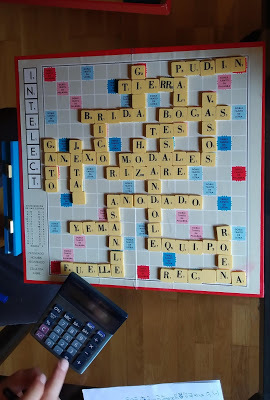 Scrabble with an antique Spanish set is a genuine
Scrabble with an antique Spanish set is a genuine pleasure for this logophile. This is Spain, and so there is an outpouring of emotional support on social and traditional media during this strange, history-making time, with a constant torrent of inspirational and humorous messages. I've only run across a few pieces of "fake news" among all this genuine love for our fellow humans. Then there are the people who make videos of themselves in quarantine who have swimming pools or a 40-acre ranch to run around in. Best of luck to those folks, but I don't have any of that.
I'm grateful that I don't feel cramped. Heck, I have a balcony I can go out on to applaud every day at 8. I have lots of loved ones I'm staying in touch with via technology. (Imagine if this had happened before the Internet! I really needed my friend and my mom to help pull me out of a major widow moment at the beginning of this.) I have a roommate, so I can even talk to someone without technology! My roommate's cat is deliciously oblivious to what's going on. He's weird, though. We gave him an empty box and he's hardly looked at it!
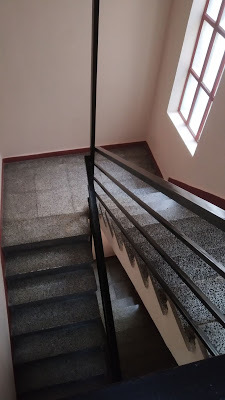 My personal gym Given my numerous intellectual pursuits, the first few weeks haven’t really been a challenge. I'm learning Portuguese with an app, I'm writing, I'm learning the music for the summer season of my choir, and I'm doing small amounts of editorial work that come in. (I'll think about the probable financial shambles when the time comes.) (Please buy my books! Keep me alive!) I get exercise on the stairs in my building (without touching even the banister) and set up a tab with my roommate when it was decided he would use the only pair of gloves to make forays into the empty streets for supplies.
My personal gym Given my numerous intellectual pursuits, the first few weeks haven’t really been a challenge. I'm learning Portuguese with an app, I'm writing, I'm learning the music for the summer season of my choir, and I'm doing small amounts of editorial work that come in. (I'll think about the probable financial shambles when the time comes.) (Please buy my books! Keep me alive!) I get exercise on the stairs in my building (without touching even the banister) and set up a tab with my roommate when it was decided he would use the only pair of gloves to make forays into the empty streets for supplies.On Friday, my roommate bought me some kitchen gloves, and on Saturday, I left the building for the first time in three weeks. Though it was a bit eerie to see my beloved busy street with only a police car on it, the lack of activity gave me a chance to slow down and notice details I'd never seen before. Peace and beauty. In order to go the grocery store, I pass some of the most elegant Modernist architecture in western Spain. I'd thought I was fully grateful to live in Zamora, but there's always room for more gratitude.
So far, so good. With some great Spanish food! The ultimate cause for gratitude.
Published on April 07, 2020 03:10
March 17, 2020
Quarantine Photo Essay
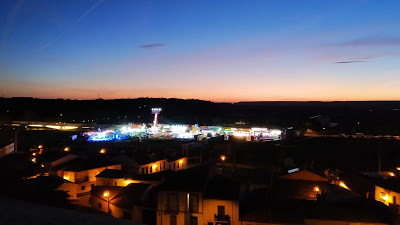 The Lenten fairground for kids, seen from the castle 3/6.
The Lenten fairground for kids, seen from the castle 3/6. 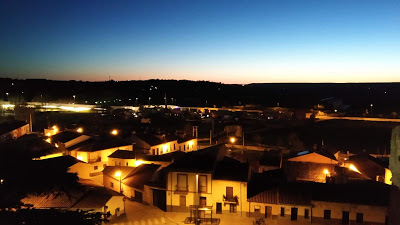 The Lenten fairground is still there, just completely shut down, 3/14.Life has changed drastically over the last few days. We're not supposed to leave the house except for essential food and hygiene reasons. I'm still okay, and in fact, being a writer, if my roommate weren't so antsy, things might seem pretty much normal. Creepy empty streets, shows of support, and the first thing to crop up among the Spanish is humor.
The Lenten fairground is still there, just completely shut down, 3/14.Life has changed drastically over the last few days. We're not supposed to leave the house except for essential food and hygiene reasons. I'm still okay, and in fact, being a writer, if my roommate weren't so antsy, things might seem pretty much normal. Creepy empty streets, shows of support, and the first thing to crop up among the Spanish is humor. Horrible toilet paper from the 70s becomes an object of desire.
Horrible toilet paper from the 70s becomes an object of desire. 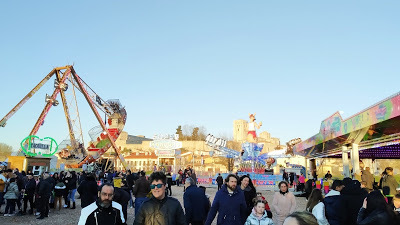 Crowded fairground, 3/8.
Crowded fairground, 3/8.  A famous comic put to timely use in a meme.
A famous comic put to timely use in a meme. 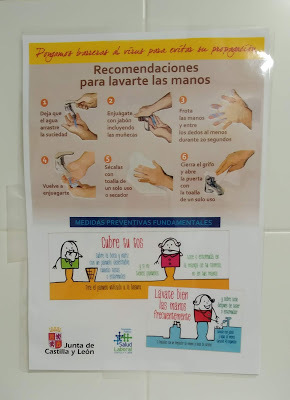 "Recommendations" in the teacher's lavatory, 3/10.
"Recommendations" in the teacher's lavatory, 3/10. "A meteorite!" "Run! We need toilet paper!"
"A meteorite!" "Run! We need toilet paper!"  Toilet paper mystery solved:
Toilet paper mystery solved:For every one who coughs,
one hundred sh*t themselves.
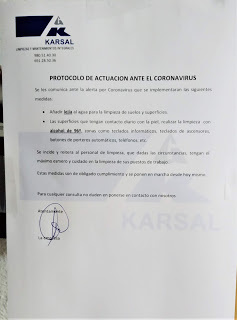 New protocols for the people who clean
New protocols for the people who clean the hallways in our apartment building, 3/10.
 They asked our grandparents to go to war;
They asked our grandparents to go to war;they'e only asking us to stay home.
Solidarity with the voluntary isolation which was
quickly becoming mandatory.
 Holy Week cancelled. Only
Holy Week cancelled. Only Pontius Pilate will go out in procession
because he's the only one
who washes his hands.
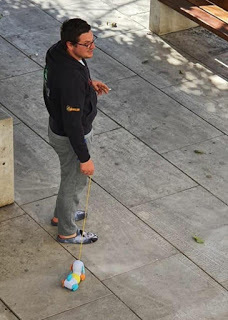 People are allowed to walk their dogs during quarantine.
People are allowed to walk their dogs during quarantine. I can't say this kind of humor amuses me.
 Day 2 of quarantine with the kids at home...
Day 2 of quarantine with the kids at home...We don't pay teachers enough.
(Truth.)
 Confusion over some of the quarantine
Confusion over some of the quarantine rules: Why are the hair salons
still open? Maybe it was this guy's idea.
(He's one of the Vice Presidents
of Spain and has always had
luxurious hair.) The idea is really to help
people who can't take care of
their own hygiene, and most hair salons
that don't serve anyone like that have closed.
I was the last customer at mine on Friday,
early afternoon.
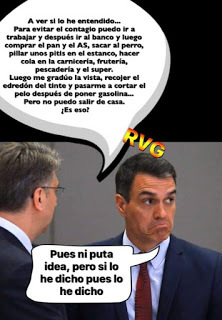 "Let's see if I understand: To avoid contagion,
"Let's see if I understand: To avoid contagion, I can go to work, to the bank, then go buy
bread, walk the dog, get some smokes, wait
in line at the butcher's, the fruit store,
fish store, and supermarket.
Then I can go to the optometrist,
pick up my comforter from the dry cleaner,
and get a haircut after I full up the car.
But I can't leave the house. Is that right?"
The President of Spain responds, "Well, I have no f*cking idea, but if that's what I said, that's what I said."
 "In order to have a group of more than 1000 people,
"In order to have a group of more than 1000 people, in Zamora we have to bring people in from elsewhere."
I don't love humor that pokes fun at Empty Spain.
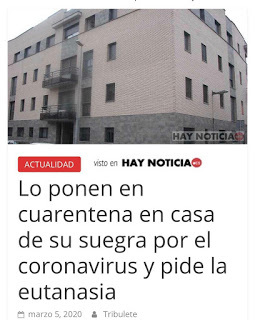 "Man quarantined with his mother-in-law
"Man quarantined with his mother-in-law requests euthanasia."
Hardy har har.
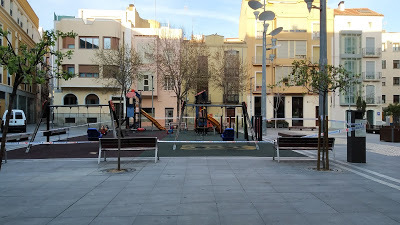 A playground cordoned off with police tape.
A playground cordoned off with police tape.The first thing that really creeped me out. 3/13.
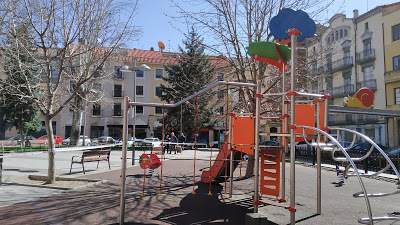 Another cordoned-off playground, 3/14,
Another cordoned-off playground, 3/14,the day I panic-bought chocolate.
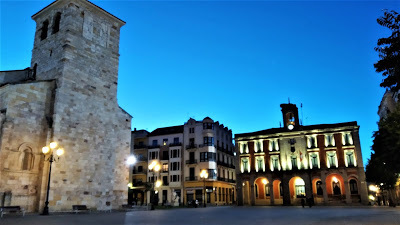 The Plaza Mayor empty on a Saturday night, 3/14.
The Plaza Mayor empty on a Saturday night, 3/14.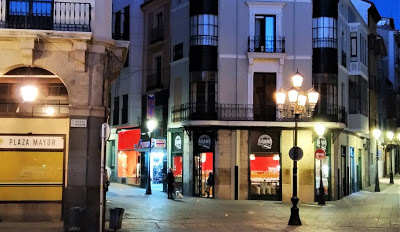 People practice social distancing, a hard concept in Spain. 3/14.
People practice social distancing, a hard concept in Spain. 3/14. 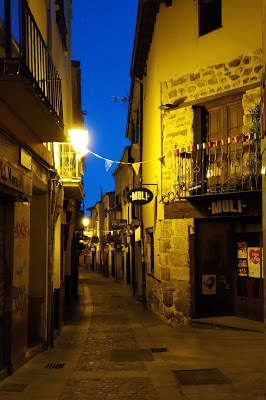 The most popular pub-crawl street, totally
The most popular pub-crawl street, totallydeserted on Saturday evening. Gave me chills.
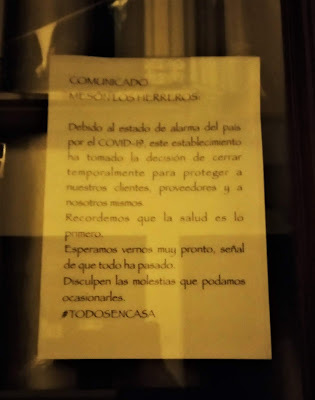 "Sorry for the trouble," one of the bars on
"Sorry for the trouble," one of the bars onthe pub-crawl street.
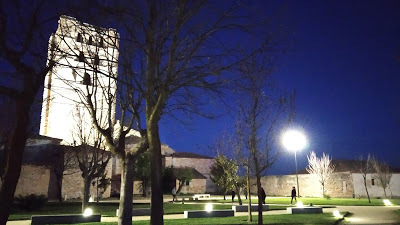 Younglings, impervious to world crises, hanging
Younglings, impervious to world crises, hangingout at the castle as if everything's normal.
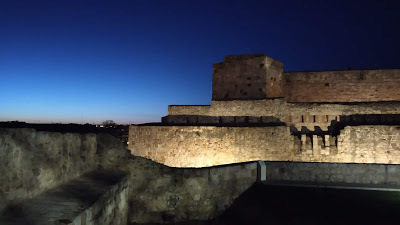 Zamora's doughty defenses can't stop a virus.
Zamora's doughty defenses can't stop a virus. 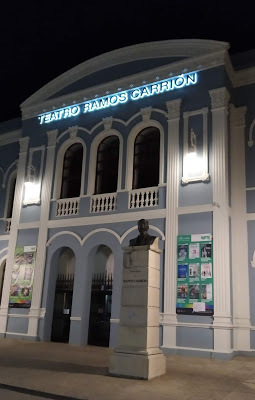 The theatre where my roommate and I
The theatre where my roommate and Iwere going to have a spectacular choir
concert this coming weekend, eerily quiet.
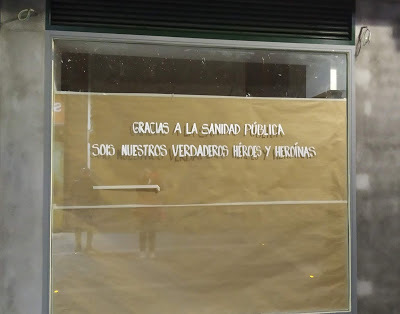 "Thank you to Public Health. You are our true heroes and heroines."
"Thank you to Public Health. You are our true heroes and heroines."Not sure any health professionals will see this,
but their heart is in the right place.
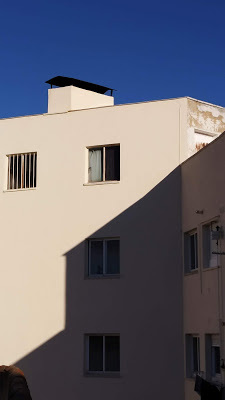 Part of the view from my quarantined apartment.
Part of the view from my quarantined apartment.It kind of reminds me Morocco.
Ah! Remember when we used to be able to travel?
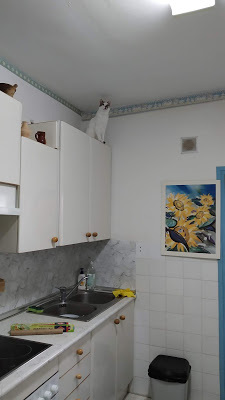 The cat seeks to avoid contamination.
The cat seeks to avoid contamination.3/16
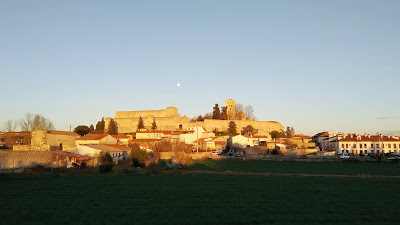 Zamora with Santiago de los Caballeros, the castle, and the cathedral under
Zamora with Santiago de los Caballeros, the castle, and the cathedral undera supermoon, 3/8. It's waiting for us. It will be there, beautiful, when this is over. If you are isolating, and are a Kindle Unlimited member, I remind you that unique Rhode Island fantasy Awash in Talent is yours to read for free! And check out the free reading listed here. (Not all, but most of the readings on that page are free.) As this situation goes on, I plan to offer more fun reading material. If people let me concentrate with all their emotional support via text message!
Published on March 17, 2020 04:59
March 3, 2020
We All Fall Down Debut a "Viral" Success
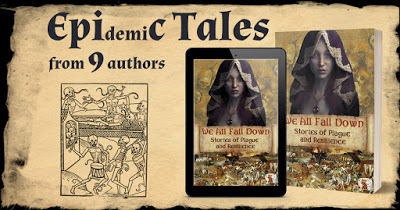 We All Fall Down has hit a nerve. It's the most successful new release I've ever had, though goodness knows I always work very hard, hoping for such results. This time, my new release has so many factors in its favor. A gorgeous cover! The support of loyal readers of eight other terrific authors! And that little something extra, a relationship to what everyone is thinking about, anyway.
We All Fall Down has hit a nerve. It's the most successful new release I've ever had, though goodness knows I always work very hard, hoping for such results. This time, my new release has so many factors in its favor. A gorgeous cover! The support of loyal readers of eight other terrific authors! And that little something extra, a relationship to what everyone is thinking about, anyway. One of our authors said, feeling quite ooky about it, "I feel like COVID-19 is a co-author."
One of our authors said, feeling quite ooky about it, "I feel like COVID-19 is a co-author."Coronavirus is not even as deadly as the yearly flu virus, so I don't feel panicked about it, personally. Considering the first round of the Black Death wiped out half the population of Europe, there's really no comparison. The stories in We All Fall Down are really universal because they illustrate the way humans bounce back, even after the worst. They're worth a read any time, truly.
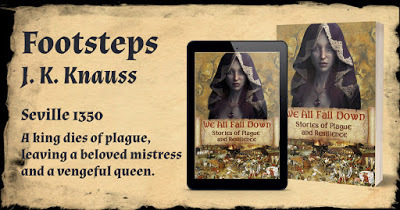 The universal buy link is here. Or go directly to your favorite store:
The universal buy link is here. Or go directly to your favorite store:Goodreads | Amazon.com | Amazon.es | Amazon.com.mx | Amazon.co.uk | Amazon.ca | Barnes and Noble | Apple iBooks | Kobo | 24 Symbols | Smashwords | Indigo | Angus & Robertson | Mondadori
It was an honor and a pleasure to work with all the authors. I'm thrilled our efforts are coming to fruition. Thank you so much for making this book a success!
Published on March 03, 2020 03:24
February 20, 2020
A Brand New Release with Eight Other Historical Fiction Authors
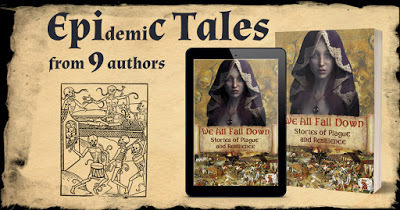
Thank you from the bottom of my heart for voting for Seven Noble Knights in the TaleFlick Discovery Contest. The week was packed with meeting new people and feeling supported, something that is all too rare for an author. Seven Noble Knights finished in 14th place. It's not a win, but it's not bad, either, considering the competition! I couldn't have done it without your support, so THANK YOU.
I don't have much to show my gratitude aside from some interesting little medieval stories for free:

Get "Trout Riot," a one-act play, in three different formats for free here.
 Get "Faded Threads," a miracle story that takes place in thirteenth-century France, in three different formats here.
Get "Faded Threads," a miracle story that takes place in thirteenth-century France, in three different formats here. Or get "Forgiveness on the Frontier," a very Spanish tenth-century miracle, in three different formats here.
Or get "Forgiveness on the Frontier," a very Spanish tenth-century miracle, in three different formats here.And now for the great cover reveal!
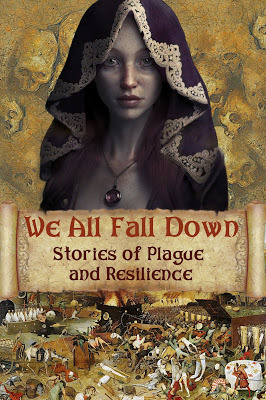
We All Fall Down: Stories of Plague and Resilience is the result of a unique collaboration between nine bestselling and award-winning historical fiction authors: yours truly, Kristin Gleeson, Lisa Yarde, David Blixt, Deborah Swift, Jean Gill, Katherine Pym, Laura Morelli, and Melodie Winawer.
Plague has no favorites.
In this anthology, USA Today, international bestselling, and award-winning authors imagine a world where anyone—rich, poor, young, old—might be well in the morning and dead by sundown.
Readers will follow in the footsteps of those who fought to rebuild shattered lives as the plague left desolation in its wake.
* An Irish woman tends her dying father while the Normans threaten her life and property—
* A Hispano-Muslim doctor fights the authorities to stem the spread of the deadly pestilence at great personal cost—
* A Tuscan street hawker and a fresco painter watch citizens perish all around them even as they paint a better future—
* A Spanish noblewoman lives at the mercy of a jealous queen after plague kills the king—
* The Black Death leaves an uncertain legacy to Dante’s son—
* In Venice, the artist Titian agonizes over a death in obscurity—
* A Scottish thief loses everything to plague and repents in the hope of preventing more losses—
* Two teenagers from 2020 time-travel to plague-stricken London and are forever changed—
* And when death rules in Ottoman-occupied Greece, a Turk decides his own fate.
Nine tales bound together by humanity’s fortitude in the face of despair: a powerful collection of stories for our own time.
In dark and deadly times, love and courage shine bright.
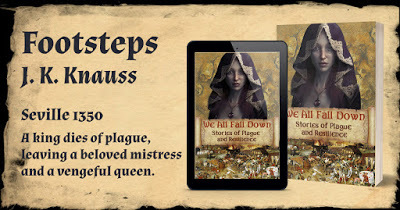
My story immerses the reader in the harrowing final years of Leonor Núñez de Guzmán y Ponce de León, the true love of Alfonso XI of Castile. Alfonso XI was the only monarch to succumb to the Black Death. Though his jealous queen stripped Leonor of all her power, she has gone down in history as the mother of Enrique II of Castile, the first king of the Trastámara line.
We All Fall Down will be available for ebook purchase on March 1! Preorder it at many venues here.
Goodreads * Barnes and Noble * Kobo * Apple iBooks * and many others!
The Amazon Kindle link will appear on release day, March 1.
Find new authors, locales, and time periods to love in this slim volume packed with substance. Softcover to follow very soon.
¡Grandes noticias para mis lectores en español! Por fin está disponible Mundos impredecibles en las tiendas Amazon: Amazon.com, Amazon.es y Amazon.com.mx.
Subscribers to my newsletter saw the amazing cover of We All Fall Down last night and found out about the magical science fantasy I'm currently working on. Just sayin'.
Published on February 20, 2020 00:30
February 10, 2020
Can You Help Seven Noble Knights Take a Trip to a Movie Studio?
2020 is shaping up to be the year of Seven Noble Knights, with tons of great news.
First and foremost, the search for a new home that started in mid-2018 is over. Medieval masterpiece Seven Noble Knights will be re-released in December 2020. You can delve into the rich tapestry of romance, revenge, war, and adventure at the end of this year! The wonderful team at Encircle Publications is getting a new cover and spruced-up edition ready as we speak.
As if that weren't wonderful enough, Seven Noble Knights is also set to appear in December 2020 in Italian! The translation is already under way. Expect to hear more about this unexpected literary gift soon.
 And most exciting news right now: Have you ever wanted to see your favorite actor get hit with a bloody cucumber while wearing medieval underpants? Now that long-awaited possibility is within your grasp!
And most exciting news right now: Have you ever wanted to see your favorite actor get hit with a bloody cucumber while wearing medieval underpants? Now that long-awaited possibility is within your grasp!
Seven Noble Knights has been selected to compete in the TaleFlick Discovery contest. With your help, this epic of medieval Spain can win a chance at being optioned for a movie or series!
Voting takes place now through February 14 at 4 p.m. Pacific/ 7 p.m. Eastern/ 1 a.m. on February 15 Central European Time. Be sure to get your vote in before time's up!
To vote, go to TaleFlick.com and click off any pop-ups. You don't have to subscribe to anything in order to vote. Near the top of the page, you will see something like this:
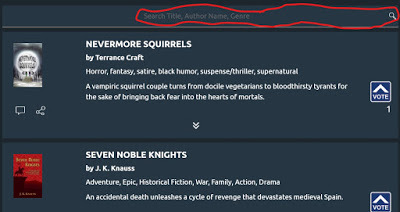
If Seven Noble Knights is not on the first page, it needs your help even more! You can search for it by typing "Seven Noble Knights" into the bar circled above and clicking the magnifying glass.
 Seven Noble Knights appears with its original cover.
Seven Noble Knights appears with its original cover.
When you have Seven Noble Knights in your sights, you can expand the description using the white arrows at the center bottom, share the contest, or comment using the square speech balloon under the book cover, which is linked up to Facebook comments.

Or, just vote, clicking the upward arrow button on the right, which I have circled in the picture above. As I mentioned, you don't have to sign in or sign up for anything to vote, so you can help Seven Noble Knights with no commitment! The whole process takes all of five seconds with a good internet connection.
The page accepts one vote per IP address. So two people using the same wifi only get one vote, but say you have a tablet at home, a dinosaur desktop you use at work, and a phone you can hook up in a cafe--each of those could be a vote!
So please click away as you are able and tell everyone you know who loves medieval epics, Spain, or great movies based on exciting legends to vote for Seven Noble Knights at TaleFlick.com!
You will have a say in what actors get which roles when casting starts!
Thanks for reading. I'm so grateful for your help in making Seven Noble Knights a movie or series!
First and foremost, the search for a new home that started in mid-2018 is over. Medieval masterpiece Seven Noble Knights will be re-released in December 2020. You can delve into the rich tapestry of romance, revenge, war, and adventure at the end of this year! The wonderful team at Encircle Publications is getting a new cover and spruced-up edition ready as we speak.
As if that weren't wonderful enough, Seven Noble Knights is also set to appear in December 2020 in Italian! The translation is already under way. Expect to hear more about this unexpected literary gift soon.
 And most exciting news right now: Have you ever wanted to see your favorite actor get hit with a bloody cucumber while wearing medieval underpants? Now that long-awaited possibility is within your grasp!
And most exciting news right now: Have you ever wanted to see your favorite actor get hit with a bloody cucumber while wearing medieval underpants? Now that long-awaited possibility is within your grasp!Seven Noble Knights has been selected to compete in the TaleFlick Discovery contest. With your help, this epic of medieval Spain can win a chance at being optioned for a movie or series!
Voting takes place now through February 14 at 4 p.m. Pacific/ 7 p.m. Eastern/ 1 a.m. on February 15 Central European Time. Be sure to get your vote in before time's up!
To vote, go to TaleFlick.com and click off any pop-ups. You don't have to subscribe to anything in order to vote. Near the top of the page, you will see something like this:

If Seven Noble Knights is not on the first page, it needs your help even more! You can search for it by typing "Seven Noble Knights" into the bar circled above and clicking the magnifying glass.
 Seven Noble Knights appears with its original cover.
Seven Noble Knights appears with its original cover.When you have Seven Noble Knights in your sights, you can expand the description using the white arrows at the center bottom, share the contest, or comment using the square speech balloon under the book cover, which is linked up to Facebook comments.

Or, just vote, clicking the upward arrow button on the right, which I have circled in the picture above. As I mentioned, you don't have to sign in or sign up for anything to vote, so you can help Seven Noble Knights with no commitment! The whole process takes all of five seconds with a good internet connection.
The page accepts one vote per IP address. So two people using the same wifi only get one vote, but say you have a tablet at home, a dinosaur desktop you use at work, and a phone you can hook up in a cafe--each of those could be a vote!
So please click away as you are able and tell everyone you know who loves medieval epics, Spain, or great movies based on exciting legends to vote for Seven Noble Knights at TaleFlick.com!
You will have a say in what actors get which roles when casting starts!
Thanks for reading. I'm so grateful for your help in making Seven Noble Knights a movie or series!
Published on February 10, 2020 10:54
January 30, 2020
Zamora's Medieval Treasures: Santa María la Nueva: It's A Riot
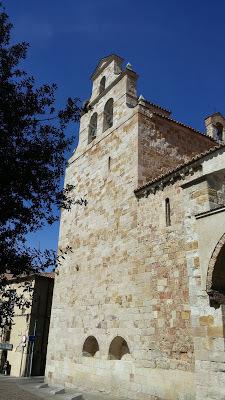 Santa María la Nueva with its Baroque
Santa María la Nueva with its Baroquebell gable and two burial niches for those
who couldn't afford a plot inside.
Photos in this post 2017-2019 Jessica Knauss Santa María la Nueva may be the most Zamoran building of all. Its history and legend make it unique in any city, in any country.
The church was built in the early twelfth century in an early, pure Romanesque style. Then, it was built in the late twelfth and early thirteenth century in a Romanesque style that was making the first changes toward Gothic. The Gothic style took over at the sides of the apse, built in the later thirteenth century, and finally the bell gable was added in the seventeenth century. In Zamora, it's not the usual practice to keep revising a church, once built. So why is Santa María la Nueva the most Zamoran of twenty-two Romanesque churches?
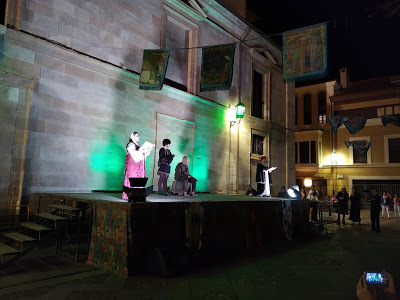 Don Benito and his son between two narrators in their leather shop
Don Benito and his son between two narrators in their leather shopin a representation of the legend associated with Santa María la Nueva
not far from that very church, during the medieval festival in Zamora, 2019 Mainly because it has its own legend. The harrowing tale takes place convincingly in the twelfth century and is complete with economic class resentment, the forging of the border with Portugal, and royal prerogative.
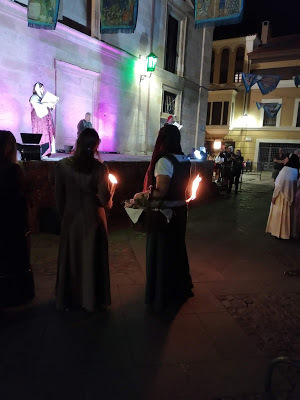 Ready with their torches to do some Romanesque damageThe legend, known as El motín de la trucha, is important in the formation of Zamoran identity. One of the first things I did when I arrived in 2017 was see a cantata written on this subject. Many other works of art have been created on this theme, including the Spanish-language play, part of the medieval festival, seen in these photos.
Ready with their torches to do some Romanesque damageThe legend, known as El motín de la trucha, is important in the formation of Zamoran identity. One of the first things I did when I arrived in 2017 was see a cantata written on this subject. Many other works of art have been created on this theme, including the Spanish-language play, part of the medieval festival, seen in these photos.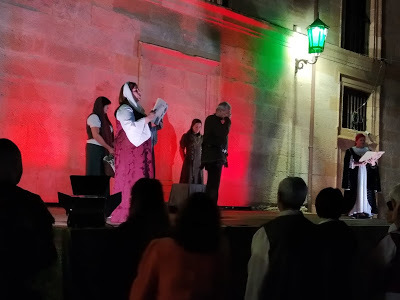 The red lights and smoke effects show what Don Benito so regrets having to do. I felt as if English speakers were missing out on an amazing story, so I've written my own short play, "Trout Riot" (my translation of El motín de la trucha), to dramatize it for you! It's free to download in many formats here. I hope my play is entertaining as well as informative, and I grant permission to any theatre group who wants to use it (giving credit where it's due, of course).
The red lights and smoke effects show what Don Benito so regrets having to do. I felt as if English speakers were missing out on an amazing story, so I've written my own short play, "Trout Riot" (my translation of El motín de la trucha), to dramatize it for you! It's free to download in many formats here. I hope my play is entertaining as well as informative, and I grant permission to any theatre group who wants to use it (giving credit where it's due, of course).These medieval legends keep only the essential information to tell the story, relying on their audience's cultural context to generate the emotional impact. Although I provide quite a bit more context in my play, I still rely on actors' performances to lend an interpretation to my written words. It was an interesting departure to write for the stage!
Now that you know the legend, tour the church where it all happened.
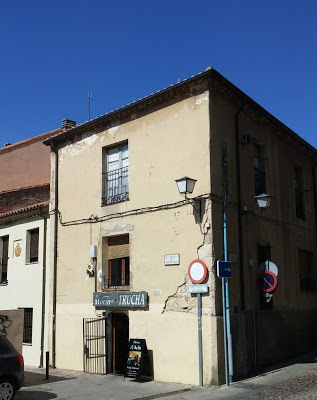 Santa María la Nueva sits nestled against the Holy Week Museum in a plaza all its own. To its side, at the beginning of calle Carniceros (Butchers Street in "Trout Riot"), an alley and a classy eatery share the name El Motín de la Trucha. There is no better place in the world for a restaurant to be named that.
Santa María la Nueva sits nestled against the Holy Week Museum in a plaza all its own. To its side, at the beginning of calle Carniceros (Butchers Street in "Trout Riot"), an alley and a classy eatery share the name El Motín de la Trucha. There is no better place in the world for a restaurant to be named that.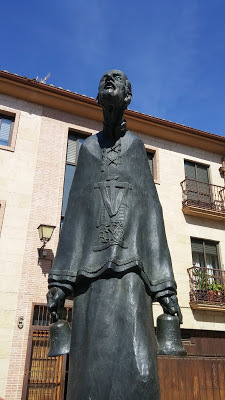 The plaza features a statue of the barandales (bell ringer) of the Brotherhood of the Holy Burial, created for the occasion of the four-hundredth anniversary of its founding (1594). The barandales walks at the head of the nighttime procession of this brotherhood on Holy Thursday of Holy Week to announce their solemn arrival with his resonant strikes of one bell in each hand. Inside Santa María la Nueva, we'll glimpse the image this brotherhood carries on a float in the procession.
The plaza features a statue of the barandales (bell ringer) of the Brotherhood of the Holy Burial, created for the occasion of the four-hundredth anniversary of its founding (1594). The barandales walks at the head of the nighttime procession of this brotherhood on Holy Thursday of Holy Week to announce their solemn arrival with his resonant strikes of one bell in each hand. Inside Santa María la Nueva, we'll glimpse the image this brotherhood carries on a float in the procession.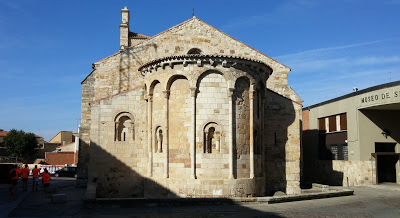 If you're at an event in the cozy auditorium of the Ethnographic Museum, windows in its corridor provide a stunning view of Santa María's early twelfth-century apse, complete with its semicircular arches, column capitals with checkerboard patterns, and some of the earliest sculptures in Zamora. Catching a sunset here in autumn, with the pinks in the sky echoing the red highlights in the church's golden stones, would be worth the plane ticket all by itself.
If you're at an event in the cozy auditorium of the Ethnographic Museum, windows in its corridor provide a stunning view of Santa María's early twelfth-century apse, complete with its semicircular arches, column capitals with checkerboard patterns, and some of the earliest sculptures in Zamora. Catching a sunset here in autumn, with the pinks in the sky echoing the red highlights in the church's golden stones, would be worth the plane ticket all by itself.The building just behind the church in this photo is the previously mentioned Holy Week Museum, the largest such of its kind in the region and maybe all Spain. It helps make this plaza an important hot spot during Holy Week as the floats on display travel in and out its specially proportioned doors.
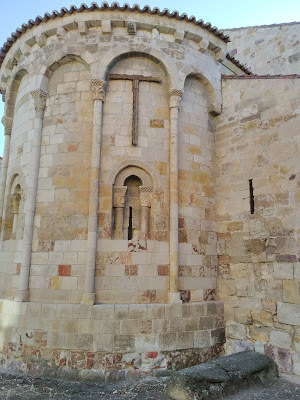 The apse is accompanied by stone sarcophagi and features a partial-indulgence tau cross, six semicircular arches, and three Romanesque slot windows with many fascinating column capitals.
The apse is accompanied by stone sarcophagi and features a partial-indulgence tau cross, six semicircular arches, and three Romanesque slot windows with many fascinating column capitals.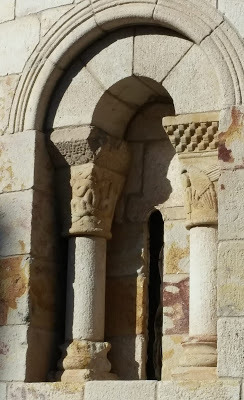 Here we have a tangled mess of what could be vines--if they didn't have forked tongues coming out the ends. I've been searching for the specific meaning of tangled serpents, and haven't found anything yet. The serpent has an interesting history in Christian iconography, but by the time this church was built, it exclusively evokes negative characteristics. I would venture to say the serpents are the tangled mess an unwitting person can get into when evil crosses their path.
Here we have a tangled mess of what could be vines--if they didn't have forked tongues coming out the ends. I've been searching for the specific meaning of tangled serpents, and haven't found anything yet. The serpent has an interesting history in Christian iconography, but by the time this church was built, it exclusively evokes negative characteristics. I would venture to say the serpents are the tangled mess an unwitting person can get into when evil crosses their path.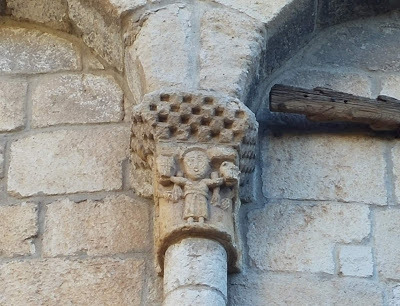 This poor fellow is being devoured by wild animals (probably wolves). Given the checkerboard pattern above, which represents choices on the spiritual path, this capital could be illustrating what happens to those who choose the wrong path. But because no sculptor of Santa María la Nueva left a record of his exact intentions, this same scene could be interpreted in the opposite way. Harking back to Celtic spiritualism, these wolves could be spirit animals who, by killing humans, allow them to be reborn in a better, stronger form. The Christian interpretation makes this a metaphor referencing Christ's resurrection as well as the way a sinner "dies" to his sins to become spiritually pure.
This poor fellow is being devoured by wild animals (probably wolves). Given the checkerboard pattern above, which represents choices on the spiritual path, this capital could be illustrating what happens to those who choose the wrong path. But because no sculptor of Santa María la Nueva left a record of his exact intentions, this same scene could be interpreted in the opposite way. Harking back to Celtic spiritualism, these wolves could be spirit animals who, by killing humans, allow them to be reborn in a better, stronger form. The Christian interpretation makes this a metaphor referencing Christ's resurrection as well as the way a sinner "dies" to his sins to become spiritually pure. 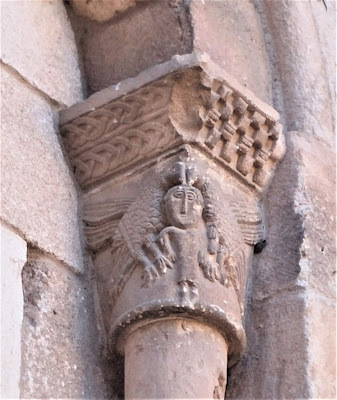 In this closeup, we can see that the style is "primitive" in the sense of being some of the first expressions of the Romanesque style. More than one critic has noted the similarity of the eyes, the symmetry, and virtual flatness to Mozarabic paintings. These sculptures share the same artistic goal of presenting the bare suggestion of forms so the viewer can more easily see past said forms to the symbolism beneath. No need for distracting realism here. It has also been suggested that these aspects have their origin even earlier than Mozarabic art, given the relatively nearby presence of San Pedro de la Nave. As we have seen on this blog, San Pedro is a well preserved seventh-century Visigothic temple, and the faces on its column capitals bear striking similarity to Santa María la Nueva's. (Similarity in itself is never enough to prove influence, but come on!)
In this closeup, we can see that the style is "primitive" in the sense of being some of the first expressions of the Romanesque style. More than one critic has noted the similarity of the eyes, the symmetry, and virtual flatness to Mozarabic paintings. These sculptures share the same artistic goal of presenting the bare suggestion of forms so the viewer can more easily see past said forms to the symbolism beneath. No need for distracting realism here. It has also been suggested that these aspects have their origin even earlier than Mozarabic art, given the relatively nearby presence of San Pedro de la Nave. As we have seen on this blog, San Pedro is a well preserved seventh-century Visigothic temple, and the faces on its column capitals bear striking similarity to Santa María la Nueva's. (Similarity in itself is never enough to prove influence, but come on!)Why does this man have birds pecking at his head? I believe they're eagles, and this scene may represent the triumph of the spirit (represented by the birds) over the weakness of the flesh (represented by the man).
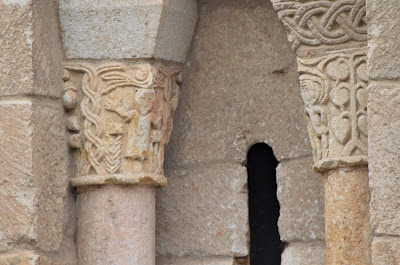 This window has the same primitive style of human figures. On the right, Adam (because he's naked) stands among sumptuous trees in Eden, and on the left, a priest prays with his hands raised among an altar and vines without beginning or end to symbolize eternity. Here you can also see the way modern restorations made their changes easily traceable. The plain block cyma over the priest is new, in contrast to the medieval, vine-covered cyma over Adam.
This window has the same primitive style of human figures. On the right, Adam (because he's naked) stands among sumptuous trees in Eden, and on the left, a priest prays with his hands raised among an altar and vines without beginning or end to symbolize eternity. Here you can also see the way modern restorations made their changes easily traceable. The plain block cyma over the priest is new, in contrast to the medieval, vine-covered cyma over Adam.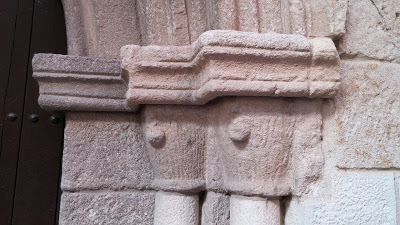 The north side's door, facing the Holy Week Museum, is said to have been built in the later twelfth century, part of the reconstruction after the fire. It's flanked by column capitals that seem to be even older than what we've seen so far. They've been exposed to more erosion on the north side, which reduces the carvings even further into their intended abstraction. Rather than a Corinthian capital with obvious leaves and fruits, these capitals suggest the idea of a Corinthian capital. It's a subtlety only someone who has spent the past two years studying Romanesque sculpture can get a kick out of.
The north side's door, facing the Holy Week Museum, is said to have been built in the later twelfth century, part of the reconstruction after the fire. It's flanked by column capitals that seem to be even older than what we've seen so far. They've been exposed to more erosion on the north side, which reduces the carvings even further into their intended abstraction. Rather than a Corinthian capital with obvious leaves and fruits, these capitals suggest the idea of a Corinthian capital. It's a subtlety only someone who has spent the past two years studying Romanesque sculpture can get a kick out of.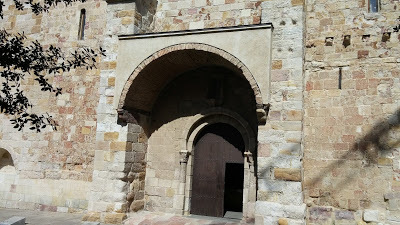 The south side has the front door everyone uses to enter the church. The door itself, with a double horseshoe arch, survives from the first construction on this spot, while the rest of the structure seen here is from the Gothic period.
The south side has the front door everyone uses to enter the church. The door itself, with a double horseshoe arch, survives from the first construction on this spot, while the rest of the structure seen here is from the Gothic period.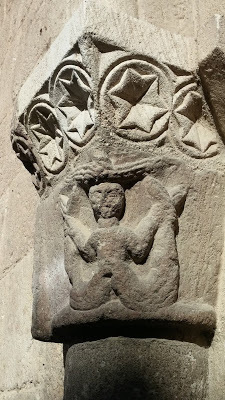 Two column capitals, also from the earliest artwork, protect the entry to the church. They look a bit out of place, as they don't fit perfectly within the space or on the same angle with their cymas. These capitals could have been moved from a different part of the church in any of the rebuilds over the years. The eroded mermaid above symbolizes the tricky seductions of carnal pleasures.
Two column capitals, also from the earliest artwork, protect the entry to the church. They look a bit out of place, as they don't fit perfectly within the space or on the same angle with their cymas. These capitals could have been moved from a different part of the church in any of the rebuilds over the years. The eroded mermaid above symbolizes the tricky seductions of carnal pleasures.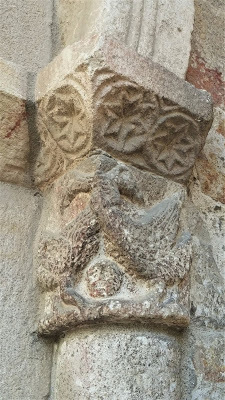 The other capital shows two doves with their necks entwined. The dove is involved in the imagery of the Holy Spirit, the human spirit yearning for peace, and the reconciliation symbolized by the dove that returned to Noah's ark with an olive branch. The seven-pointed stars in the cyma may symbolize the perfect union of the earthly and the celestial.
The other capital shows two doves with their necks entwined. The dove is involved in the imagery of the Holy Spirit, the human spirit yearning for peace, and the reconciliation symbolized by the dove that returned to Noah's ark with an olive branch. The seven-pointed stars in the cyma may symbolize the perfect union of the earthly and the celestial.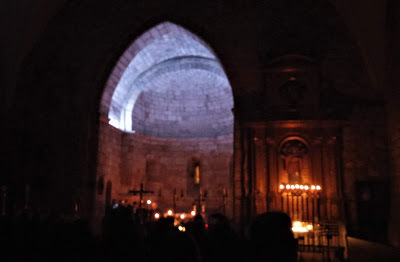 The simplicity of the apse is on full display during a Lenten candlelight
The simplicity of the apse is on full display during a Lenten candlelight Stations of the Cross service in 2019. Walking inside, we're met with spaciousness. In the thirteenth century, the triple nave was reduced to a single one by removing rows of columns, which opened up the space considerably. We've seen this in San Cipriano, as well, and it seems to be a typical move in the transition from Romanesque to Gothic.
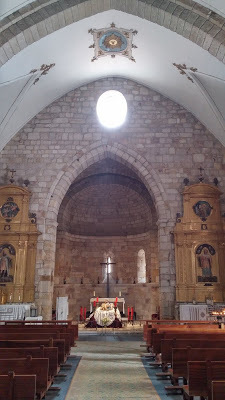 The apse interior is beautifully simple, with an archaic horseshoe triumphal arch and half-circle arches at the windows, which we've already seen from the outside. The subsequent layers of construction, including a pointed Gothic arch, threw off the Romanesque balance of the nave. Contemplated as in the above photo, all the sight lines are slightly askew.
The apse interior is beautifully simple, with an archaic horseshoe triumphal arch and half-circle arches at the windows, which we've already seen from the outside. The subsequent layers of construction, including a pointed Gothic arch, threw off the Romanesque balance of the nave. Contemplated as in the above photo, all the sight lines are slightly askew.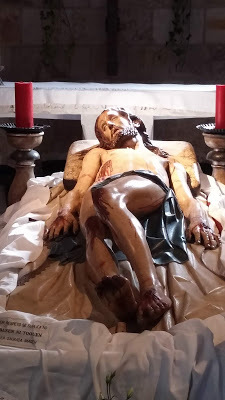 The recumbent Christ in front of the main altar was attributed to famous sculptor Gregorio Fernández, who was said to have created it under the influence of the sorrow he felt when his true love entered a convent. The image is now known to be the work of Fernández's disciple, Francisco Fermín, in the year 1635. It was originally intended for a funerary chapel in a monastery that no longer exists. It was moved several times before finding its home here in 1966. Since then, it has been the center of the Holy Thursday night procession. The singing brotherhood goes out in procession rain or shine because they carry the image in a glass casket that protects it from any possible weather.
The recumbent Christ in front of the main altar was attributed to famous sculptor Gregorio Fernández, who was said to have created it under the influence of the sorrow he felt when his true love entered a convent. The image is now known to be the work of Fernández's disciple, Francisco Fermín, in the year 1635. It was originally intended for a funerary chapel in a monastery that no longer exists. It was moved several times before finding its home here in 1966. Since then, it has been the center of the Holy Thursday night procession. The singing brotherhood goes out in procession rain or shine because they carry the image in a glass casket that protects it from any possible weather.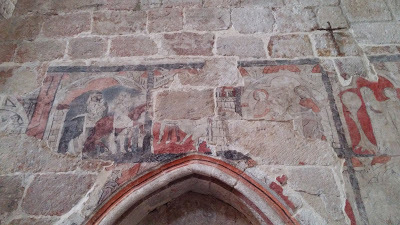 Remnants of fourteenth-century linear Gothic paintings (I love the colors!) on the southern wall remind us that medieval people did not like to look at bare brick. They used every surface available to tell their stories. Here, "reading" the images from right to left, we have a sequence from the life of Mary: the Visitation, the Annunciation, possibly the Nativity (but most of the scene is gone), and the Flight into Egypt. The wooden cross embedded in the wall, upper right, is likely a medieval Station of the Cross. As darkly pictured above, Stations of the Cross services still take place here during Lent, with the priest and many helpers making a tour around the small space, stopping at the modern versions of the embedded cross seen here to recite texts and prayers. The sense of continuity with the past thrilled me.
Remnants of fourteenth-century linear Gothic paintings (I love the colors!) on the southern wall remind us that medieval people did not like to look at bare brick. They used every surface available to tell their stories. Here, "reading" the images from right to left, we have a sequence from the life of Mary: the Visitation, the Annunciation, possibly the Nativity (but most of the scene is gone), and the Flight into Egypt. The wooden cross embedded in the wall, upper right, is likely a medieval Station of the Cross. As darkly pictured above, Stations of the Cross services still take place here during Lent, with the priest and many helpers making a tour around the small space, stopping at the modern versions of the embedded cross seen here to recite texts and prayers. The sense of continuity with the past thrilled me.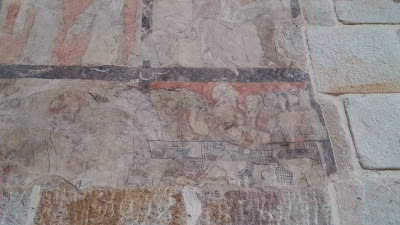 Fainter scenes on the adjacent wall depict the life of Jesus. Here, the Last Supper stands out with its checked tablecloth. All of these paintings were coated with limewash in accordance with early modern hygiene practices. The resulting chemical reactions and perhaps exposure to light before the paintings were covered account for the deterioration. The Gothic paintings were revealed in the twentieth century. Tastes and motivations for renovating old buildings continue to change.
Fainter scenes on the adjacent wall depict the life of Jesus. Here, the Last Supper stands out with its checked tablecloth. All of these paintings were coated with limewash in accordance with early modern hygiene practices. The resulting chemical reactions and perhaps exposure to light before the paintings were covered account for the deterioration. The Gothic paintings were revealed in the twentieth century. Tastes and motivations for renovating old buildings continue to change.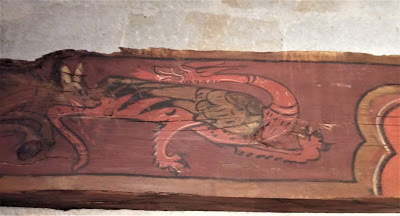 The foot of the church contains a museum where artwork found during restoration efforts is displayed, such as this marvelous fourteenth-century dragon painted on wood.
The foot of the church contains a museum where artwork found during restoration efforts is displayed, such as this marvelous fourteenth-century dragon painted on wood.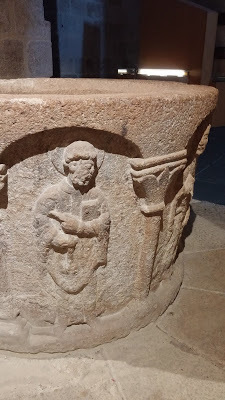 A baptismal font has sculptures in a fully rounded, mature Romanesque style depicting Jesus' baptism. As seen here, the sculptures have been worn away more at the base, where they're not protected by the arches--evidence of clerical robes rubbing up against them while helping people in and out of the full immersion basin.
A baptismal font has sculptures in a fully rounded, mature Romanesque style depicting Jesus' baptism. As seen here, the sculptures have been worn away more at the base, where they're not protected by the arches--evidence of clerical robes rubbing up against them while helping people in and out of the full immersion basin.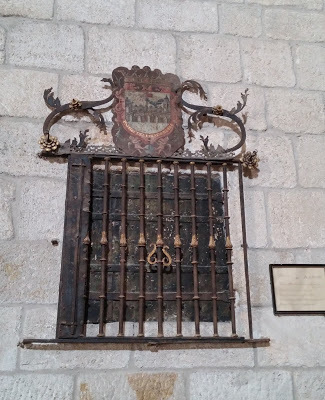 Book lovers (like yours truly) enjoy the box embedded in the wall with an elaborate grille protecting it. The inscription beside it reads, "Archive of the Noble Knights of Zamora from the twelfth century to 1836. Royal executive letters from 1342. Books of agreements from 1546 to 1835. References to historical events: Trout Riot in 1158, Monsalve's challenge to Mazariegos in 1531." It looks as if I have quite a bit more investigation to do!
Book lovers (like yours truly) enjoy the box embedded in the wall with an elaborate grille protecting it. The inscription beside it reads, "Archive of the Noble Knights of Zamora from the twelfth century to 1836. Royal executive letters from 1342. Books of agreements from 1546 to 1835. References to historical events: Trout Riot in 1158, Monsalve's challenge to Mazariegos in 1531." It looks as if I have quite a bit more investigation to do!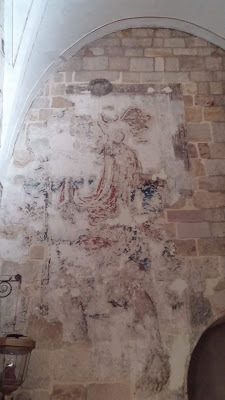 Returning to the head of the church, to the left of the apse, where it would be seen as the faithful walked in the door, we have the lime-eaten and over-painted but now recovered painting of St. Christopher. This saint was popular throughout the Middle Ages and often appears in just the spot where where it would be the first sight upon entering a church. The legend tells that Christopher (Latin for "bearer of Christ") agreed to carry a small child across a river. He came across unexpected perils from the water and from the portentous weight of the child, who revealed himself on the opposite bank to be Christ. St. Christopher's journey is a metaphor for the arduous spiritual path of the devout.
Returning to the head of the church, to the left of the apse, where it would be seen as the faithful walked in the door, we have the lime-eaten and over-painted but now recovered painting of St. Christopher. This saint was popular throughout the Middle Ages and often appears in just the spot where where it would be the first sight upon entering a church. The legend tells that Christopher (Latin for "bearer of Christ") agreed to carry a small child across a river. He came across unexpected perils from the water and from the portentous weight of the child, who revealed himself on the opposite bank to be Christ. St. Christopher's journey is a metaphor for the arduous spiritual path of the devout.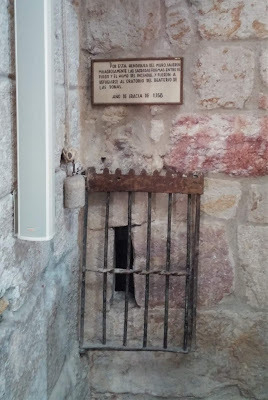 Below St. Christopher's foot and to the left, someone who cared about Zamoran history marked a piece of evidence that the Trout Riot really happened. Near the corner and rather lower down than I would've expected for a miraculous escape route, the hole through which the consecrated communion wafers flew safely toward the convent is protected by a seemingly ancient grate. A plaque reads, "Through this fissure in the wall, the Sacred Forms miraculously exited from amid the fire and smoke and took refuge at the oratory of the Convent of the Ladies. In the year of grace 1158." It is highly unlikely that this is that very crack because this wall is part of the Romanesque rebuild. From what I know of medieval practicality, the rebuilders wouldn't have added a crack back in on purpose. And, no, this hole doesn't go through to the outside--sadly for the legend, happily for the people who visit or sit through mass in the winter.
Below St. Christopher's foot and to the left, someone who cared about Zamoran history marked a piece of evidence that the Trout Riot really happened. Near the corner and rather lower down than I would've expected for a miraculous escape route, the hole through which the consecrated communion wafers flew safely toward the convent is protected by a seemingly ancient grate. A plaque reads, "Through this fissure in the wall, the Sacred Forms miraculously exited from amid the fire and smoke and took refuge at the oratory of the Convent of the Ladies. In the year of grace 1158." It is highly unlikely that this is that very crack because this wall is part of the Romanesque rebuild. From what I know of medieval practicality, the rebuilders wouldn't have added a crack back in on purpose. And, no, this hole doesn't go through to the outside--sadly for the legend, happily for the people who visit or sit through mass in the winter.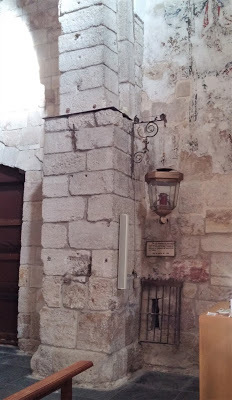 The Trout Riot legend may or may not have a grain of truth to it. The architecture says, "Yes! Of course it's true! Just look at my evidence and folkloric backup." True or not, it's a fascinating slice of medieval Spanish life with its own gem of medieval art and architecture.
The Trout Riot legend may or may not have a grain of truth to it. The architecture says, "Yes! Of course it's true! Just look at my evidence and folkloric backup." True or not, it's a fascinating slice of medieval Spanish life with its own gem of medieval art and architecture.Don't forget to get your free dramatic interpretation of the medieval legend here!
Published on January 30, 2020 09:27
December 15, 2019
A Celebration of Unpredictable Worlds, Now Also Known as Mundos impredecibles!
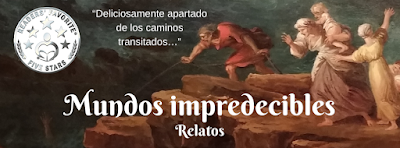 My newsletter subscribers have already heard this news, but I’m thrilled to announce here that my five-star-rated short story collection,
Unpredictable Worlds
, has been translated into Spanish.
My newsletter subscribers have already heard this news, but I’m thrilled to announce here that my five-star-rated short story collection,
Unpredictable Worlds
, has been translated into Spanish.English-speaking readers, please see below the Spanish text for the special way Unpredictable Worlds is celebrating the birth of its Spanish sibling.
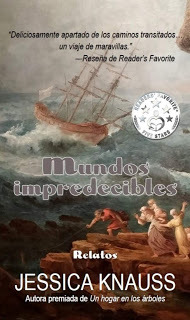 El libro con rinocerontes, matrimonios felices, mujeres que encuentran su esencia fuerte, y las miradas más raras al mundo del trabajo ya está disponible para disfrutar en el idioma que dio origen al realismo mágico. Estoy rebosante de orgullo al anunciar la llegada al mundo de la traducción de Unpredictable Worlds al español: Mundos impredecibles.
El libro con rinocerontes, matrimonios felices, mujeres que encuentran su esencia fuerte, y las miradas más raras al mundo del trabajo ya está disponible para disfrutar en el idioma que dio origen al realismo mágico. Estoy rebosante de orgullo al anunciar la llegada al mundo de la traducción de Unpredictable Worlds al español: Mundos impredecibles.Encontré a un joven promesa de traductor, Carlos Orlando Castaño Franco, que tiene un don lingüístico genial y ha sabido transformar mis textos más extraños con un estilo ajustado a cada relato. He mirado personalmente la traducción de este colombiano para asegurar un español internacional pero no por ello falto de personalidad.
Estos relatos, que son un reglo ideal para el lector a la búsqueda de lo diferente e impredecible, son disponibles ahora para los siguientes dispositivos:
Barnes & Noble * Apple * Kobo
Y muy pronto lo verás en Scribd, Tolino, Streetlib, Amazon, Google Play e Inscribe, si estos son tus mercados preferidos.
¡Celebra conmigo! ¡Hazte con tu ejemplar de Mundos impredecibles ya!
Una edición en tapa blanda está prevista para el año 2020, ¡que se acerca!
 Seeing
Unpredictable Worlds
in Spanish makes me feel like celebrating! So for those of you who don’t yet have Unpredictable Worlds in Kindle yet, this is your opportunity! Get it 75% off for two weeks only, now through December 31. The new year will see the price go back up!
Seeing
Unpredictable Worlds
in Spanish makes me feel like celebrating! So for those of you who don’t yet have Unpredictable Worlds in Kindle yet, this is your opportunity! Get it 75% off for two weeks only, now through December 31. The new year will see the price go back up!Nowhere else can you get so much zaniness for only 99 cents!
You might have 99 problems, but a source for strange stories will not be one!
Makes a perfect Christmas gift for that reader in your life eclectic tastes who you’re never sure has read a certain book yet or not. Trust me, they haven’t read this one yet.
Sale valid in equivalent currencies on all Amazon sites.
 My publisher has also decided to end 2019 with a bang.
Awash in Talent
is only 99 cents in ebook for the month of December. The latest (5-star!) review says, “A great learning experience of perspectives and thought. Stories that explain real-world phobias. Excellent writing.”
My publisher has also decided to end 2019 with a bang.
Awash in Talent
is only 99 cents in ebook for the month of December. The latest (5-star!) review says, “A great learning experience of perspectives and thought. Stories that explain real-world phobias. Excellent writing.”Get the 75% discount on Amazon US, and you’ll be all set for some original reading in the New Year.
Published on December 15, 2019 05:45
September 13, 2019
Tenth Anniversary
 The last time I wrote about my wedding anniversary, I made the announcement on this blog that my beloved husband had died.
The last time I wrote about my wedding anniversary, I made the announcement on this blog that my beloved husband had died.It's been three years, and I've survived and put together some semblance of life. He was taken from me far too soon, but I've mostly accepted that the summer of 2016 was his time. The thing about this kind of grief is that it always hurts. It's not something you get over. It's something you live with. Or not.
 The death of Stanley Arthur Coombs is the worst thing that's ever happened to me, and I don't care who knows it. With amazing help from beloved friends and family, I've moved forward. (Moving on is not the right phrasal verb because it connotes leaving things behind, forgetting. Forgetting is the last thing you want to do when all you have of the love of your life is memories.)
The death of Stanley Arthur Coombs is the worst thing that's ever happened to me, and I don't care who knows it. With amazing help from beloved friends and family, I've moved forward. (Moving on is not the right phrasal verb because it connotes leaving things behind, forgetting. Forgetting is the last thing you want to do when all you have of the love of your life is memories.)Even so, a world without Stanley still feels sudden and verging on unbearable. Is it worth living in such a world? It's exhausting to have to answer that every morning before I get out of bed.
 I've taken measures to make this question easier to answer yes to. Every day, I read a few pages of a book my husband and I had read together. I meditate, a new practice we had discussed many times before he passed away. I live with a friend because although I needed space to grieve when I first arrived here, by my second year, I needed the kind of human contact only living with someone provides. Most dramatically, I moved to Spain.
I've taken measures to make this question easier to answer yes to. Every day, I read a few pages of a book my husband and I had read together. I meditate, a new practice we had discussed many times before he passed away. I live with a friend because although I needed space to grieve when I first arrived here, by my second year, I needed the kind of human contact only living with someone provides. Most dramatically, I moved to Spain. Moving to a foreign country far from friends and family might not seem like the wisest self-care option. For me, it's the only way to make a world without Stanley tolerable. We had discussed moving to Spain together shortly before he died, so coming here has been, in part, keeping a promise to him. I tried to arrive on our wedding anniversary to ensure that his spirit would stay with me.
Moving to a foreign country far from friends and family might not seem like the wisest self-care option. For me, it's the only way to make a world without Stanley tolerable. We had discussed moving to Spain together shortly before he died, so coming here has been, in part, keeping a promise to him. I tried to arrive on our wedding anniversary to ensure that his spirit would stay with me. Spain is where I've always wanted to live, where I feel (ironically) at home. I keep up with American friends and family through the magic of technology. I go to Manolo Garcia concerts (the best thing anyone can do!). I eat delicious food. I do things I never imagined, like sing in a choir in the Teatro Principal or go on a pilgrimage. I take trips to see the kinds of amazing sights I've always wanted to, sights that make me want to write novels. If I'm feeling down, I can step out into the street and see Romanesque and Modernist architecture, hear beautiful Spanish used to express all manner of feelings, smell the aromas from the bakeries or the burgeoning life in the river, or watch the birds fly home in the soft, changing colors of the sunset over the castle.
Spain is where I've always wanted to live, where I feel (ironically) at home. I keep up with American friends and family through the magic of technology. I go to Manolo Garcia concerts (the best thing anyone can do!). I eat delicious food. I do things I never imagined, like sing in a choir in the Teatro Principal or go on a pilgrimage. I take trips to see the kinds of amazing sights I've always wanted to, sights that make me want to write novels. If I'm feeling down, I can step out into the street and see Romanesque and Modernist architecture, hear beautiful Spanish used to express all manner of feelings, smell the aromas from the bakeries or the burgeoning life in the river, or watch the birds fly home in the soft, changing colors of the sunset over the castle. These small things don't necessarily make life worth living in and of themselves. But pausing to appreciate them honors what Stanley taught me about what's important in life. These things make getting up in a world without the love of my life a bit less of a burden.
These small things don't necessarily make life worth living in and of themselves. But pausing to appreciate them honors what Stanley taught me about what's important in life. These things make getting up in a world without the love of my life a bit less of a burden. I'm also working on long-term goals, such as ensuring my continued residency in Spain, getting my writing translated into Spanish, and writing new surprising works. All of these activities require enormous optimism I think has always been a part of me, but found its raison d'etre in Stanley, and took a nosedive at the end of July 2016. The optimism is coming back up now, though it may need extra coaxing.
I'm also working on long-term goals, such as ensuring my continued residency in Spain, getting my writing translated into Spanish, and writing new surprising works. All of these activities require enormous optimism I think has always been a part of me, but found its raison d'etre in Stanley, and took a nosedive at the end of July 2016. The optimism is coming back up now, though it may need extra coaxing. Of course, I always imagined I would celebrate my tenth wedding anniversary with my husband. The tenth, and many beyond that. Perhaps we would watch the now-antique video below and marvel. "That doesn't seem like ten years ago!" Or "We thought we were in love then, but we had no idea! It just keeps getting better! How can this be?" But here I am, with only a blog to mark this special occasion.
Of course, I always imagined I would celebrate my tenth wedding anniversary with my husband. The tenth, and many beyond that. Perhaps we would watch the now-antique video below and marvel. "That doesn't seem like ten years ago!" Or "We thought we were in love then, but we had no idea! It just keeps getting better! How can this be?" But here I am, with only a blog to mark this special occasion.Look, my love. Look at those two starry-eyed kids. That was us!
Start at 57:00 to skip the raw footage and view only the edited cut.
Knauss & Coombs Wedding from Frank Breen on Vimeo.
Published on September 13, 2019 00:30
July 24, 2019
The Best Castle
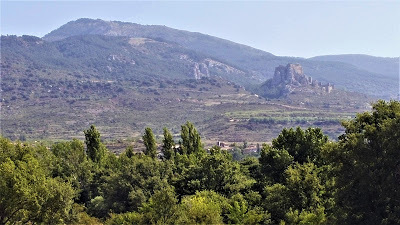 Loarre, camouflaged against its rocky outcrop
Loarre, camouflaged against its rocky outcropPhotos in this post 2019 Jessica Knauss That's right. Through years of hard toil and the sweat of my brow, I've visited castle after castle--some in Britain, one in the United States, but mostly in Spain--and I'm pleased to report I've found the best one.
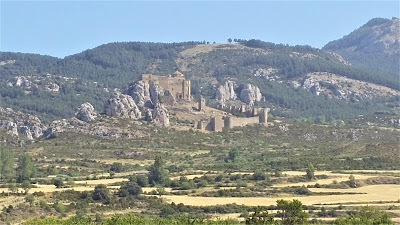 Loarre's first line of defense is that if they approached from the mountain pass,
Loarre's first line of defense is that if they approached from the mountain pass, the enemies couldn't see Loarre, but Loarre could see them.Its name is Loarre, and I'm only disappointed it's not closer to where I live. My friend Daniel and I found Loarre in our trusty guidebook of Romanesque architecture in Spain by Jaime Cobreros. I'm always up for a castle, anyway, but the rave review Cobreros writes for Loarre would've convinced even the most entrenched castle skeptic. We planned to see it on our way out of Aragón after my week-long university course in Jaca.
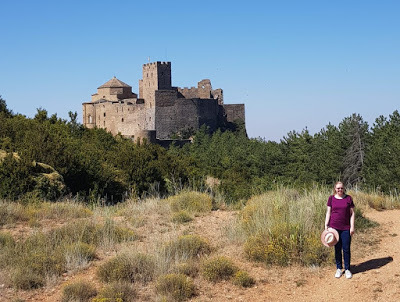 Photo 2019 Daniel Sanz Talk about a grand finale! Driving up, it seemed as if we would be the only visitors. There was nothing for miles around. Loarre looked like the only castle in the world, and it was beautiful from every angle.
Photo 2019 Daniel Sanz Talk about a grand finale! Driving up, it seemed as if we would be the only visitors. There was nothing for miles around. Loarre looked like the only castle in the world, and it was beautiful from every angle. This panorama catches most of what remains of the thirteenth-century wall. But we're talking about an eleventh-century military building. That's not to say the architects didn't appreciate the aesthetics of this spot, only that everything they did also had a purpose beyond loveliness.
This panorama catches most of what remains of the thirteenth-century wall. But we're talking about an eleventh-century military building. That's not to say the architects didn't appreciate the aesthetics of this spot, only that everything they did also had a purpose beyond loveliness.The outer wall was not built by the original architects, but it still combines usefulness and beauty. Created in the thirteenth century, it defended the castle and the town around it. They didn't have to build the wall all the way around because the rocks, the original and ultimate defense, were already there, and will continue there long after the castle falls into ruin. The town moved down the hill in the sixteenth century, and people took many stones from the wall to build new houses.
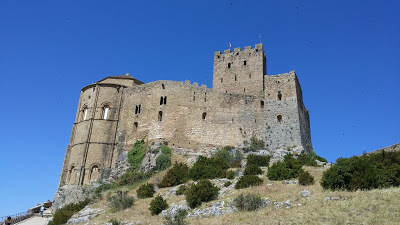 The topmost tower is also the oldest: the keep. Loarre was only remodeled for about one hundred years. Although it was used at different times as a castle, as a monastery, and as a palace, it's all a single architectural style: Romanesque. Here on the left, the apse of the monastery's enormous church is clearly seen. The double windows in the middle section are also from the time of the monastery. They would've started out as arrow slits in the time of the castle.
The topmost tower is also the oldest: the keep. Loarre was only remodeled for about one hundred years. Although it was used at different times as a castle, as a monastery, and as a palace, it's all a single architectural style: Romanesque. Here on the left, the apse of the monastery's enormous church is clearly seen. The double windows in the middle section are also from the time of the monastery. They would've started out as arrow slits in the time of the castle.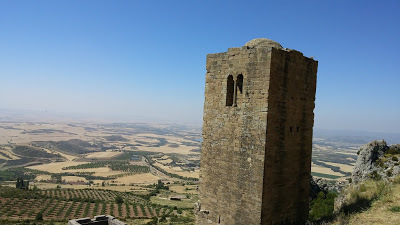 A watchtower, end of the eleventh century, separate from the rest of the castle,
A watchtower, end of the eleventh century, separate from the rest of the castle,takes in the view perfectly. The tower may have been connected
to the castle with a bridge or tunnel at some point. The day we visited was hazy, but we still got a good sense of why this location was chosen. The entire area known as the Hoya de Huesca, and more, is laid out before the castle. The guide said that on a clear day, she's seen the cathedral towers in Zaragoza, 85 kilometers to the south.
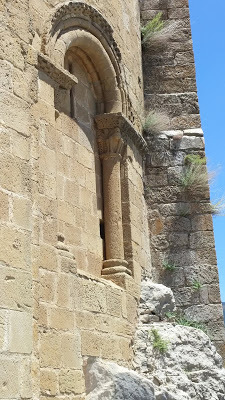 Walking around the castle to get to the grand doorway, you see the church windows up close. There's no mistaking the checkerboard pattern and perfect half-circle. It couldn't be any more Romanesque. It was about this time that we realized we did not have the castle all to ourselves. Not only was it doing a booming cultural tourist business, but people seemed to be coming from all over to do sports, too.
Walking around the castle to get to the grand doorway, you see the church windows up close. There's no mistaking the checkerboard pattern and perfect half-circle. It couldn't be any more Romanesque. It was about this time that we realized we did not have the castle all to ourselves. Not only was it doing a booming cultural tourist business, but people seemed to be coming from all over to do sports, too.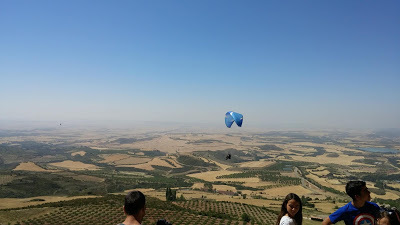 Loarre is a popular paragliding spot. Jump off a rock and float around the best castle.
Loarre is a popular paragliding spot. Jump off a rock and float around the best castle.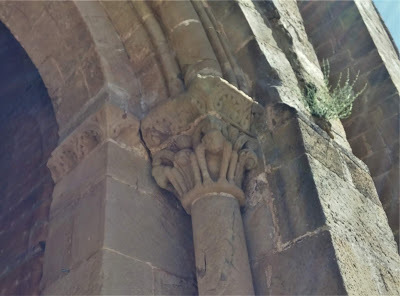 The grand doorway is flanked by columns with capitals. This may look like a leafy Corinthian column, but look more closely: it's crouching monkeys!
The grand doorway is flanked by columns with capitals. This may look like a leafy Corinthian column, but look more closely: it's crouching monkeys!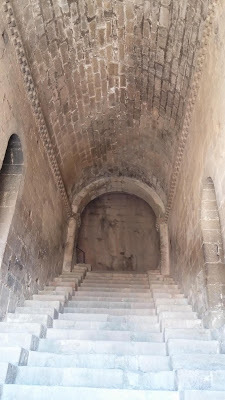 The grand doorway opens onto this grand staircase. In this castle, you would think the only direction was up. But the architecture uses the uneven terrain on which the castle sits to create a maze-like path upward designed to confound enemies. It's an effective strategy probably borrowed from Hispano-Muslim architecture. It would've been impossible for anyone who had never entered the castle before to mount an attack. Indeed, Loarre's impregnable fame led to no one even attempting to attack it.
The grand doorway opens onto this grand staircase. In this castle, you would think the only direction was up. But the architecture uses the uneven terrain on which the castle sits to create a maze-like path upward designed to confound enemies. It's an effective strategy probably borrowed from Hispano-Muslim architecture. It would've been impossible for anyone who had never entered the castle before to mount an attack. Indeed, Loarre's impregnable fame led to no one even attempting to attack it.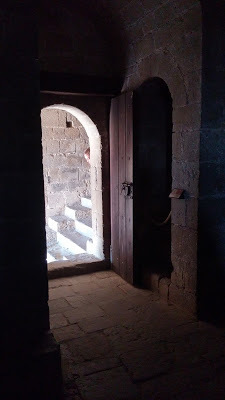 Note that the stairs are quite a bit lower in the center. The guide proposed that this could have to do with "protocol," or to have the advantage in an attack, but given what we saw later on, Daniel proposed that the different levels provided drainage. On rainy days, people used the high stairs, and the rain used the low stairs. I'm going with that idea.
Note that the stairs are quite a bit lower in the center. The guide proposed that this could have to do with "protocol," or to have the advantage in an attack, but given what we saw later on, Daniel proposed that the different levels provided drainage. On rainy days, people used the high stairs, and the rain used the low stairs. I'm going with that idea.Halfway up the stairs, a small doorway lets you into the Crypt of Santa Quiteria.
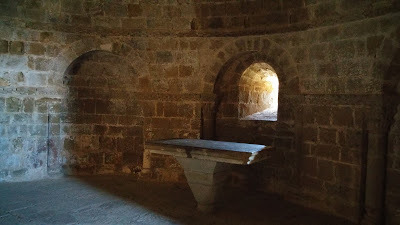 This small, rounded chapel was used for burial services, and since its wall is the castle's outer wall, it's built like a fort and has a couple of secret escape routes.
This small, rounded chapel was used for burial services, and since its wall is the castle's outer wall, it's built like a fort and has a couple of secret escape routes.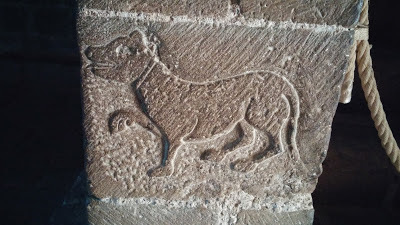 In the door jamb, a Romanesque artist portrayed Santa Quiteria's faithful dog.
In the door jamb, a Romanesque artist portrayed Santa Quiteria's faithful dog.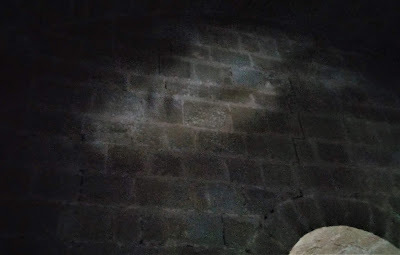 The angles between the door and the windows of the crypt led to a shadowbox effect. Over the crypt door, we watched the moving silhouettes of people walking down the main staircase and wondered what the eleventh-century monks and soldiers thought about such an uncanny show.
The angles between the door and the windows of the crypt led to a shadowbox effect. Over the crypt door, we watched the moving silhouettes of people walking down the main staircase and wondered what the eleventh-century monks and soldiers thought about such an uncanny show.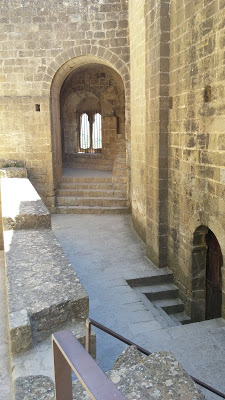 Leaving the crypt, at the top of the stairs, you're confronted with choices and strange changing volumes and angles that would confuse you if you didn't have a guide.
Leaving the crypt, at the top of the stairs, you're confronted with choices and strange changing volumes and angles that would confuse you if you didn't have a guide.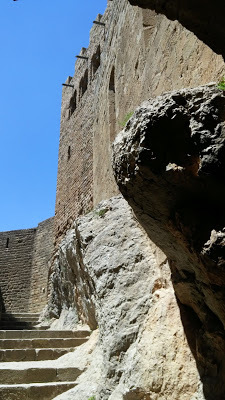 The builders took full advantage of the rock, and left evidence of their sturdiness in many unexpected places.
The builders took full advantage of the rock, and left evidence of their sturdiness in many unexpected places.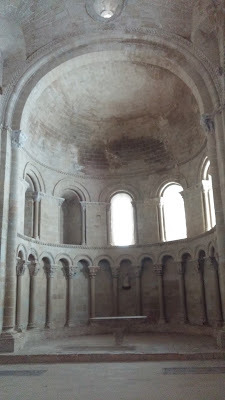 The church isn't twisted. This is some strange
The church isn't twisted. This is some strangecamera phenomenon.
The Church of San Pedro would be worth visiting all by itself. The monks who moved in during the second half of the eleventh century spared no expense in constructing a grandiose place of worship that reaches for the heavens. Large windows flood the blind arches and 84 decorated capitals with light. There's space here for a hundred monks or more.
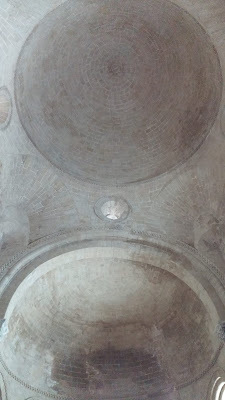 The lovely dome with four oculi increase the sense of expansiveness.
The lovely dome with four oculi increase the sense of expansiveness.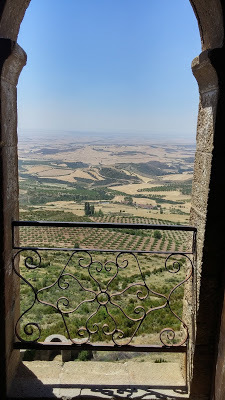 As this window demonstrates, this side of the church is a sheer drop.
As this window demonstrates, this side of the church is a sheer drop.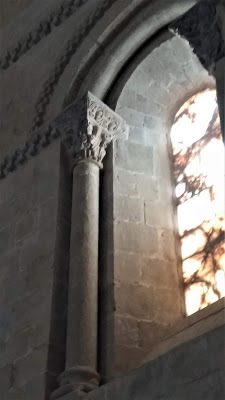 Alabaster, a plentiful resource in Aragón, covers some of the upper windows.
Alabaster, a plentiful resource in Aragón, covers some of the upper windows.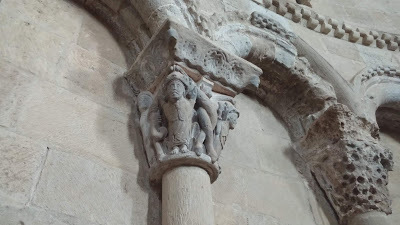 The capitals include mythological figures ...
The capitals include mythological figures ...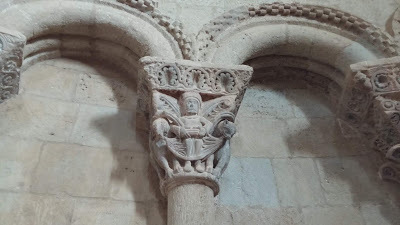 ... Biblical figures ...
... Biblical figures ...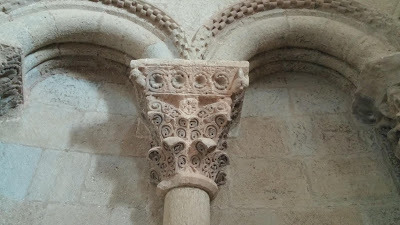 ... and plant designs.
... and plant designs. 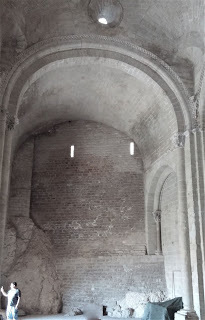 The foot of the church is a little bit curved to follow the unique landscape. Note the rocky formation that was left as a reminder of exactly where we are. It's also possible the rock was considered God's perfect architecture, and as such, shouldn't be tampered with.
The foot of the church is a little bit curved to follow the unique landscape. Note the rocky formation that was left as a reminder of exactly where we are. It's also possible the rock was considered God's perfect architecture, and as such, shouldn't be tampered with.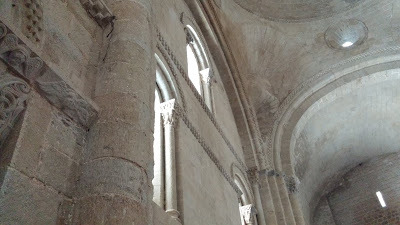 Even the capitals up too high to see have scenes on them.
Even the capitals up too high to see have scenes on them. 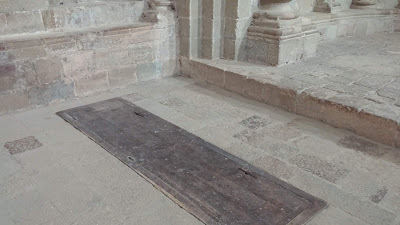 There are two doors in the floor of the nave near the apse.
There are two doors in the floor of the nave near the apse.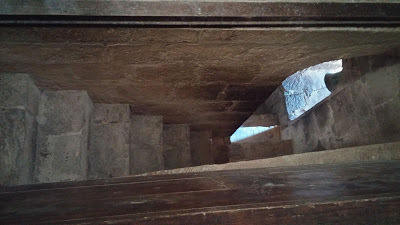 The guide opened a door to reveal one of the passageways from the crypt. I would never have known we were right above the crypt from the path we took. This passage had two uses, one religious and one military. First, the door could be opened during services in the crypt and the monks in the church would be able to hear everything. It served this purpose many times in the eleventh century. Second, if an enemy had made it to the crypt and found this passage, it was too narrow to climb the stairs with a sword and a shield, forcing the enemy to choose between defense and offense and decreasing the chances he could accomplish anything against you. As I mentioned, it never served this purpose, but the architects get mad strategy points for this.
The guide opened a door to reveal one of the passageways from the crypt. I would never have known we were right above the crypt from the path we took. This passage had two uses, one religious and one military. First, the door could be opened during services in the crypt and the monks in the church would be able to hear everything. It served this purpose many times in the eleventh century. Second, if an enemy had made it to the crypt and found this passage, it was too narrow to climb the stairs with a sword and a shield, forcing the enemy to choose between defense and offense and decreasing the chances he could accomplish anything against you. As I mentioned, it never served this purpose, but the architects get mad strategy points for this.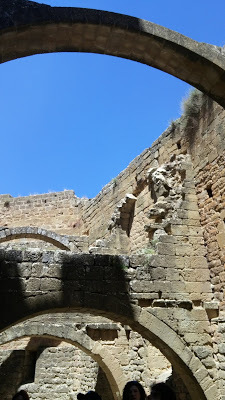 Leaving the church, you come upon the monks' dormitories. They kept livestock in the space below and slept above. In this way, they took advantage of the ecological heat generated by the livestock. Winters here at the foot of the Pyrenees could be deadly cold.
Leaving the church, you come upon the monks' dormitories. They kept livestock in the space below and slept above. In this way, they took advantage of the ecological heat generated by the livestock. Winters here at the foot of the Pyrenees could be deadly cold. 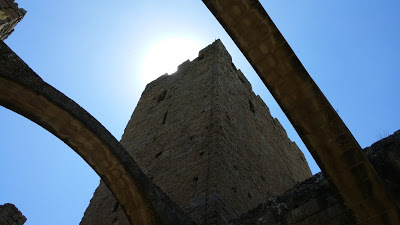 The arches were built as mere supports for the rooms, which have since disappeared. Now that the arches have been revealed again, they're highly admired by architecture historians, the guide said.
The arches were built as mere supports for the rooms, which have since disappeared. Now that the arches have been revealed again, they're highly admired by architecture historians, the guide said. 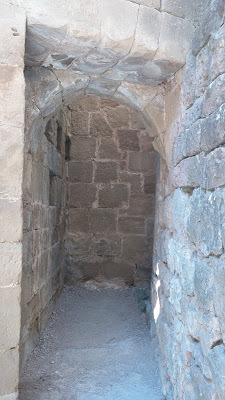 In the part below, with the livestock, the guide showed us this room, which she told us is where monks and probably the soldiers before them did their business into a pit which has since disappeared. Why didn't they have sewer chutes to direct waste immediately outside the castle? The guide says they couldn't drill through the rock, for one, and for another, the drop was too sheer on all sides, making it too dangerous. No one wanted to risk his life relieving himself. And so the ingenious sewer system of Loarre was born.
In the part below, with the livestock, the guide showed us this room, which she told us is where monks and probably the soldiers before them did their business into a pit which has since disappeared. Why didn't they have sewer chutes to direct waste immediately outside the castle? The guide says they couldn't drill through the rock, for one, and for another, the drop was too sheer on all sides, making it too dangerous. No one wanted to risk his life relieving himself. And so the ingenious sewer system of Loarre was born.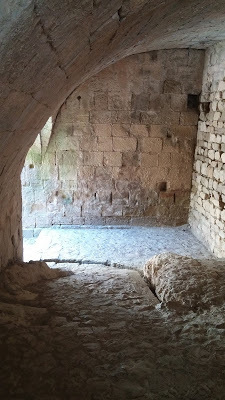 See that "crack" in the sloped floor? It's actually plumbing. It leads from a cistern near the bodega and uses gravity to evacuate rainwater (and what comes out of the privy room!) using the force of gravity all the way out of the castle, keeping it rainwater fresh. Was the creator of this feat of engineering also the architect who came up with so many wonderful strategic defenses?
See that "crack" in the sloped floor? It's actually plumbing. It leads from a cistern near the bodega and uses gravity to evacuate rainwater (and what comes out of the privy room!) using the force of gravity all the way out of the castle, keeping it rainwater fresh. Was the creator of this feat of engineering also the architect who came up with so many wonderful strategic defenses? 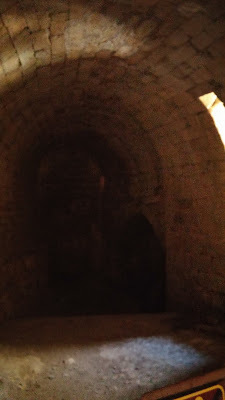 The bodega, where the monks stored their wine and grain, served as a prison in the time of the castle garrison. The guide said twentieth-century renovators found a skeleton manacled to the wall at the back.
The bodega, where the monks stored their wine and grain, served as a prison in the time of the castle garrison. The guide said twentieth-century renovators found a skeleton manacled to the wall at the back.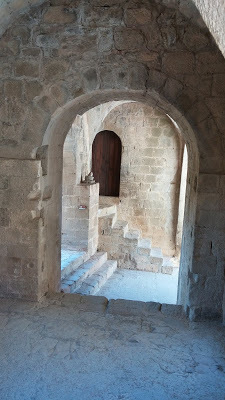 Confusing passages full of beautiful angles.
Confusing passages full of beautiful angles.This is taken from where the weapons were stored.
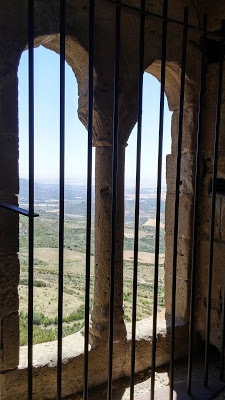 This is one of the lovely double windows
This is one of the lovely double windows visible below.
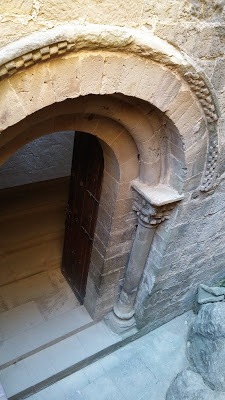 At some point during the visit, you can look
At some point during the visit, you can look back on the entrance to the church from above.
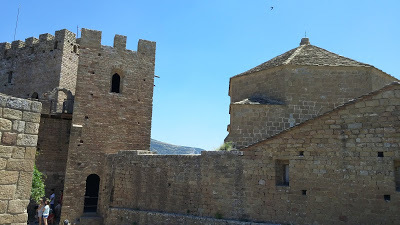 Finally, the visit arrives at the summit, which is the oldest part of the castle. Here we see the homage tower or keep, just a little higher than the cupola of the church.
Finally, the visit arrives at the summit, which is the oldest part of the castle. Here we see the homage tower or keep, just a little higher than the cupola of the church.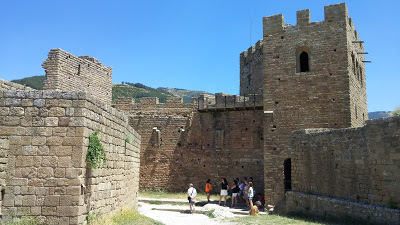
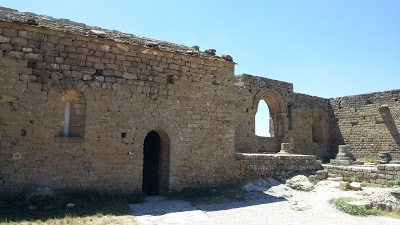 Across the arms patio from the keep, a large vista point probably created in the time of the monks gives great views. In the foreground, the tiny Church of Santa Maria would have served the original castle garrison of no more than fifteen soldiers.
Across the arms patio from the keep, a large vista point probably created in the time of the monks gives great views. In the foreground, the tiny Church of Santa Maria would have served the original castle garrison of no more than fifteen soldiers.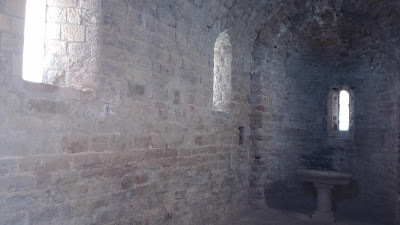 The little church is built with walls as thick as the rest of the castle, and indeed, forms part of the outer defense. I visited here first, and when I came out, Daniel asked me what it was like inside. "It's really old, and you can tell it's really old, so I love it," I said.
The little church is built with walls as thick as the rest of the castle, and indeed, forms part of the outer defense. I visited here first, and when I came out, Daniel asked me what it was like inside. "It's really old, and you can tell it's really old, so I love it," I said.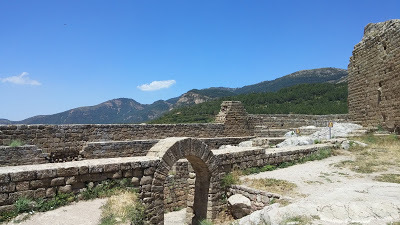 Looking back toward the start of the Pyrenees from the arms patio.
Looking back toward the start of the Pyrenees from the arms patio. 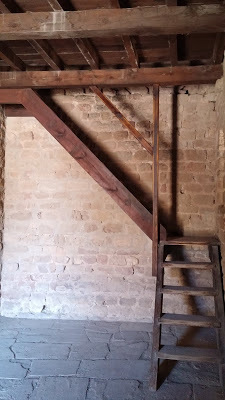 In order to climb the towers, the castle managers have provided these wooden staircases, which struck me as exactly what must've been here before.
In order to climb the towers, the castle managers have provided these wooden staircases, which struck me as exactly what must've been here before.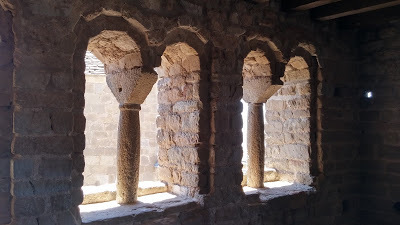 These gorgeous windows serve watchtower purposes because they're high enough and far enough inside the arms plaza to be out of range of any eleventh-century weaponry.
These gorgeous windows serve watchtower purposes because they're high enough and far enough inside the arms plaza to be out of range of any eleventh-century weaponry.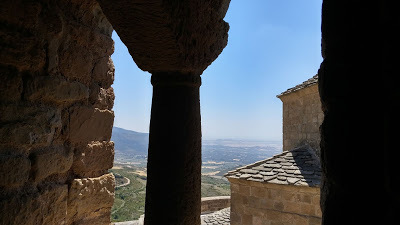 On a clear day, you can see Zaragoza.
On a clear day, you can see Zaragoza.
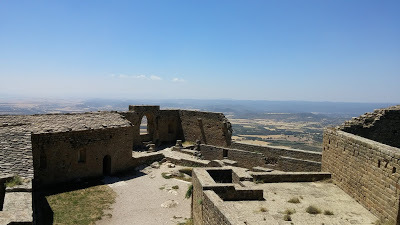 The Church of Santa Maria and the Hoya de Huesca beyond;
The Church of Santa Maria and the Hoya de Huesca beyond;barracks buildings on the right
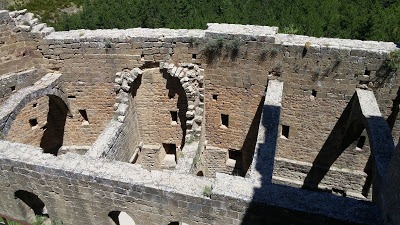 The monks' dorms seen from the keep
The monks' dorms seen from the keep 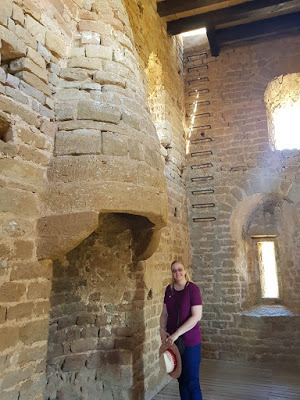 Photo 2019 Daniel Sanz The master suite, at the top of the keep, where everyone would retreat to in case of attack, has a lovely chimney for keeping the winter chill off. They say the chimney has come down to us in perfect condition, directly from the eleventh century.
Photo 2019 Daniel Sanz The master suite, at the top of the keep, where everyone would retreat to in case of attack, has a lovely chimney for keeping the winter chill off. They say the chimney has come down to us in perfect condition, directly from the eleventh century. 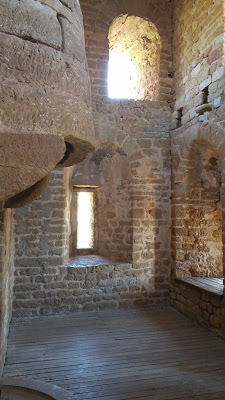 The room is not large, but it's not lacking anything an eleventh-century soldier would need.
The room is not large, but it's not lacking anything an eleventh-century soldier would need.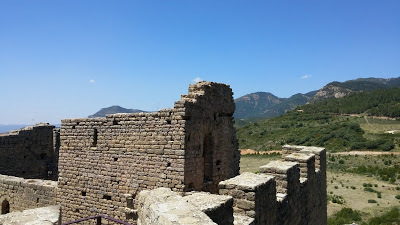 Why has Loarre come through the ages without the interference of later architectural styles? Easy. The border moved, and the King of Aragón saw fit to move the base of military operations along with it to a place called Montearagón. I don't think Montearagón enjoyed the same good luck as Loarre, and not much, if anything, survives to this day.
Why has Loarre come through the ages without the interference of later architectural styles? Easy. The border moved, and the King of Aragón saw fit to move the base of military operations along with it to a place called Montearagón. I don't think Montearagón enjoyed the same good luck as Loarre, and not much, if anything, survives to this day. 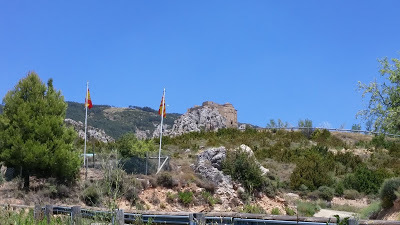 The last angle: Loarre seen from the "campsite" restaurant Climbing back down the castle, avoiding the sun, aching with thirst, I decided Loarre is the best castle I've had the privilege of exploring. Do you agree?
The last angle: Loarre seen from the "campsite" restaurant Climbing back down the castle, avoiding the sun, aching with thirst, I decided Loarre is the best castle I've had the privilege of exploring. Do you agree?Daniel and I stuffed our empty stomachs at a "campsite" restaurant (read: a rustic place that gives you tremendous amounts of fresh food from the area, prepared for the delight of foodie Instagrammers) not far from the meeting points for rafting and paragliding. Loarre was never attacked, but it conquered my heart.
Published on July 24, 2019 06:18
July 20, 2019
The Miracles of Santa Maria de Salas
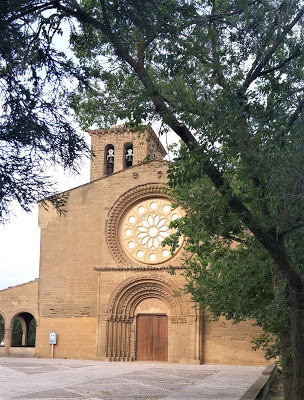 Santa Maria de Salas outside Huesca
Santa Maria de Salas outside HuescaPhotos in this post 2019 Jessica Knauss unless otherwise indicated As we've seen with glorious Villalcázar de Sirga, the Cantigas de Santa Maria have a few favorite shrines the poets returned to again and again, sure they would find another good miracle to tell. The exceptionally powerful Virgin of Villasirga has fourteen Cantigas miracles to her credit. Visiting that shrine in January seemed like the ultimate pilgrimage for a cantiguera like me.
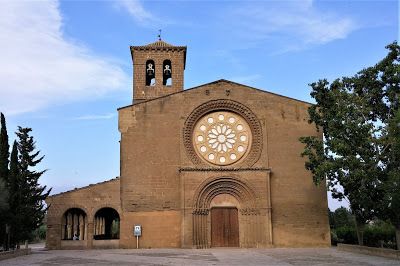 But! I wanted to keep busy in July, and found a week-long course to take on medieval manuscripts at the University of Zaragoza in Jaca. Jaca is at the foot of the Pyrenees Mountains in the province of Huesca, in the old kingdom of Aragón. Of course, my friend Daniel wanted to take advantage of being so far from our respective homes in Castilla y León to sightsee. While looking for things to do in the area (there's no lack, believe me!), I found that there is a Cantigas shrine in the outskirts of the capital of Huesca with no fewer than sixteen miracles. Sixteen! Two more than Villasirga!
But! I wanted to keep busy in July, and found a week-long course to take on medieval manuscripts at the University of Zaragoza in Jaca. Jaca is at the foot of the Pyrenees Mountains in the province of Huesca, in the old kingdom of Aragón. Of course, my friend Daniel wanted to take advantage of being so far from our respective homes in Castilla y León to sightsee. While looking for things to do in the area (there's no lack, believe me!), I found that there is a Cantigas shrine in the outskirts of the capital of Huesca with no fewer than sixteen miracles. Sixteen! Two more than Villasirga!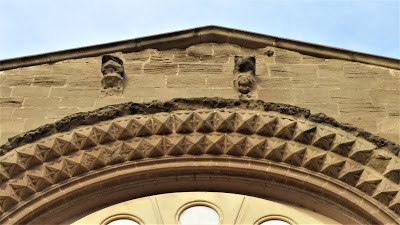 Romanesque corbels placed up high after a reconstruction I had to go. We took an afternoon trip to Huesca and saw the amazing cathedral and museum, but my hopes for seeing the miracle-working image were dashed at the tourist office when the man said Santa Maria de Salas was closed for the foreseeable future.
Romanesque corbels placed up high after a reconstruction I had to go. We took an afternoon trip to Huesca and saw the amazing cathedral and museum, but my hopes for seeing the miracle-working image were dashed at the tourist office when the man said Santa Maria de Salas was closed for the foreseeable future.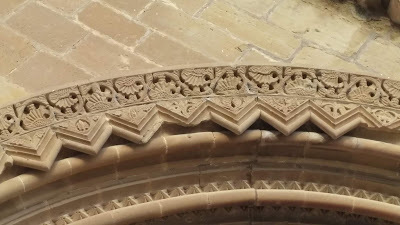 The front doorway is worth lingering over.I had to content myself with a look around the outside of the impressive edifice. Without further ado, here are the sixteen wonderful miracles that happened in Salas, Huesca, in the thirteenth century.
The front doorway is worth lingering over.I had to content myself with a look around the outside of the impressive edifice. Without further ado, here are the sixteen wonderful miracles that happened in Salas, Huesca, in the thirteenth century.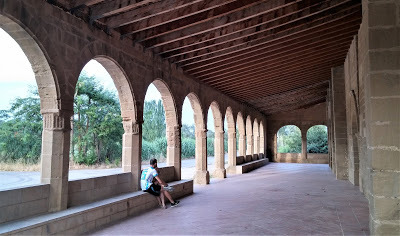 A couple uses the enormous arcade as their own hangout. Cantiga 43: A couple unable to have children makes the pilgrimage to Salas, offering his weight in wax for candles if Holy Mary will grant them a child. Sure enough, the wife has a beautiful son nine months after their return home to Daroca. But does she give the Virgin of Salas the promised wax? No, she waits seven years, raising her child as if he weren't a miracle for which she should give thanks. When he's seven, the boy catches a fever and dies. His father wants to bury him, but his mother says they should give him to Mary, along with the wax they promised so long ago. Six days later, they lay their son in his coffin before the altar, and tearing out her hair in grief, the wife asks Mary to sympathize with the loss of her son and bring him back. "Help me so I don't annoy you with my incessant pleas," she says! Upon this, the child is heard crying inside the coffin. The whole town comes to see the great miracle.
A couple uses the enormous arcade as their own hangout. Cantiga 43: A couple unable to have children makes the pilgrimage to Salas, offering his weight in wax for candles if Holy Mary will grant them a child. Sure enough, the wife has a beautiful son nine months after their return home to Daroca. But does she give the Virgin of Salas the promised wax? No, she waits seven years, raising her child as if he weren't a miracle for which she should give thanks. When he's seven, the boy catches a fever and dies. His father wants to bury him, but his mother says they should give him to Mary, along with the wax they promised so long ago. Six days later, they lay their son in his coffin before the altar, and tearing out her hair in grief, the wife asks Mary to sympathize with the loss of her son and bring him back. "Help me so I don't annoy you with my incessant pleas," she says! Upon this, the child is heard crying inside the coffin. The whole town comes to see the great miracle.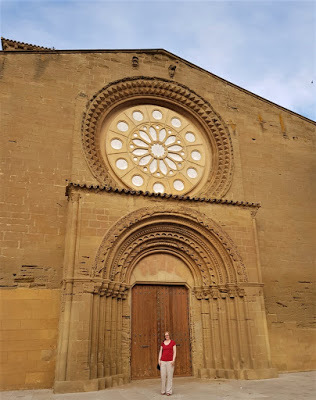 Salas and me
Salas and mePhoto 2019 Daniel Sanz Cantiga 44: A nobleman loses his goshawk during a hunt. After searching far and wide for the valuable bird, the nobleman makes a wax goshawk and presents it to Our Lady of Salas at her altar, asking for the return of his raptor. He stays to hear mass, and before it's over, the goshawk flies into the church and alights on his hand as if it's ready to go hunting.
Having seen the church, I can imagine the way a hawk would fly around inside it. It's the perfect size, as you can see in the photo.
Cantiga 109: Five demons attack a man, relentlessly tormenting him. He heads straight to Salas, but when the church is in sight, the devils don't let him continue. Two friars arrive and help the man toward the church. After an antisemitic exchange of doctrinal value we would question today, the devils figure Mary will make them let go of their victim and head out of their own volition.
Cantiga 114: A woman is a great devotee of the Virgin of Salas. She always places long wax candles at her altar and asks for protection for her dear son. One day, the son's enemies beat him to a pulp, such that it's not likely he'll live to see the next day. His mother takes him home and bandages him, commending him to Holy Mary, who cures him at once. As soon as the bandages are on, the wounds disappear without even a scar. The son tells his mother to take the bandages off, and when they see the great miracle, they go to Salas to tell everyone about it.
Cantiga 129: In a fierce battle, a warrior receives an arrow right through his eye. It reaches the base of his neck, and all his companions think he's dead. But he's not. He tells them he'll make an offering in Salas if he's cured. So they pull the arrow out of his eye, and miraculously, he's fine. In fact, he can now see out of the eye better than he did before. He makes the pilgrimage to Salas, telling everyone about the beautiful miracle.
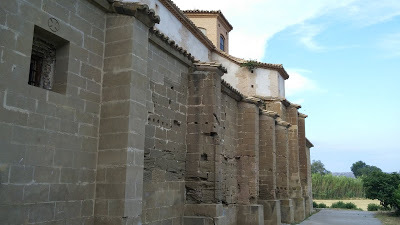 It looks like time for another reconstruction. Cantiga 161: A vintner is in the habit of making pilgrimages to Salas, carrying an image of Holy Mary with him as a talisman. One day in August, at home, he sees a big storm coming. He takes the image to his vineyard and asks Mary to protect his vines. "I consider it to be yours, although my wife and I till it as our own," he says, making a celestially binding contract of fealty. The hail severely damages all the other vineyards in the area, but the one that's been pledged to Mary is spared. Further, tendrils that spread from that vineyard and intertwine with others in other vineyards are also spared, even though the rest of the vines in those other vineyards are broken.
It looks like time for another reconstruction. Cantiga 161: A vintner is in the habit of making pilgrimages to Salas, carrying an image of Holy Mary with him as a talisman. One day in August, at home, he sees a big storm coming. He takes the image to his vineyard and asks Mary to protect his vines. "I consider it to be yours, although my wife and I till it as our own," he says, making a celestially binding contract of fealty. The hail severely damages all the other vineyards in the area, but the one that's been pledged to Mary is spared. Further, tendrils that spread from that vineyard and intertwine with others in other vineyards are also spared, even though the rest of the vines in those other vineyards are broken.Cantiga 163: A man in Huesca loses at dice and renounces Holy Mary. Upon speaking this blasphemy, he's crippled, unable to move or speak. Through signs, he asks to be taken to Salas, where he's able to speak enough to make a promise never to play dice again. His body is immediately healed and for the rest of his life, the man praises Holy Mary.
This cantiga makes an appearance in Law and Order in Medieval Spain .
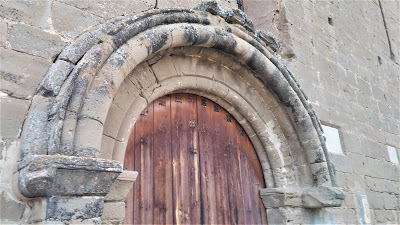 Cantiga 164: An innocent monk (a devotee of the Blessed Virgin) is accused of having his own money coined. The abbot, a nobleman with strong ties to Aragonese royalty, decides to have the monk arrested. The monk flees into the church at Salas, claiming sanctuary. The abbot calls the monk outside, and when he dutifully leaves the church, he's seized and thrown out of the churchyard. The image of Mary moves her Child away from her and gives a cry so loud that the earth trembles. Both figures pale and lose all their beauty. Everyone understands these phenomena as evidence of heavenly displeasure. The abbot orders the return of the monk and enters the church with all his men with ropes about their necks in penance. The Bishop of Huesca arrives and declares that amends must be made to Holy Mary. Upon this utterance, Mary clasps her Son to her again and shows that they pardon the abbot. However, the images never recover their color, as a reminder of how much the false arrest displeased them.
Cantiga 164: An innocent monk (a devotee of the Blessed Virgin) is accused of having his own money coined. The abbot, a nobleman with strong ties to Aragonese royalty, decides to have the monk arrested. The monk flees into the church at Salas, claiming sanctuary. The abbot calls the monk outside, and when he dutifully leaves the church, he's seized and thrown out of the churchyard. The image of Mary moves her Child away from her and gives a cry so loud that the earth trembles. Both figures pale and lose all their beauty. Everyone understands these phenomena as evidence of heavenly displeasure. The abbot orders the return of the monk and enters the church with all his men with ropes about their necks in penance. The Bishop of Huesca arrives and declares that amends must be made to Holy Mary. Upon this utterance, Mary clasps her Son to her again and shows that they pardon the abbot. However, the images never recover their color, as a reminder of how much the false arrest displeased them.Cantiga 166: A man's limbs are twisted and he is paralyzed for five years. He promises that if he goes to Salas and gets well, he'll donate a large measure of wax every year. He is healed forthwith. He's able to walk to Salas nimbly, carrying the wax himself.
This cantiga has an especially fun melody that sounds good in all the versions I've heard. The above video has the advantage of having been filmed inside the sanctuary of Santa Maria de Salas! Watch it to glimpse what I was unable to.
Cantiga 167: The small son of a Moorish lady who lives in Borja dies from a terrible disease. The woman witnesses how the Christians go to Salas and hears of Mary's miracles. She decides to go to Salas herself with a wax son and her son's body. She keeps vigil all night before the altar, appealing to Mary's sympathy. Her son comes back to life, even though he had been dead for three days. The woman converts to Christianity.
This is another of my favorite melodies.
Cantiga 168: A woman in Lleida has several children, but loses them all within a short time. Her grief for the last one is so deep that she nearly goes mad. She begs Mary for him and waits for two days. When she sees he won't revive, she takes him to Salas and raises him up at the altar. The boy comes back to life right there in her arms.
This miracle was found in writing. Finding a miracle on the Iberian Peninsula in writing before the Cantigas got it down is unusual enough that the poets mention it what is almost certainly every time.
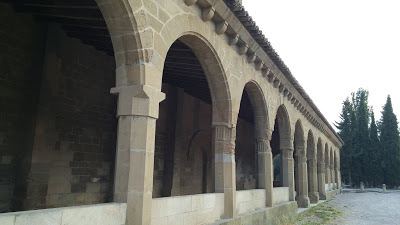 Cantiga 171: A barren couple promises to make the pilgrimage to Salas if they're granted a child. Of course, a lovely boy arrives. They raise him for two years and then set out on the promised pilgrimage. When crossing a river on horseback, mother and child fall into the water. Although the mother makes it out, they can't find the boy, no matter how hard they look. The husband thinks they should go home, but the wife says they should continue to Salas and complain. As they continue, the wife prays constantly for the Virgin's help. When they step inside the church, they see their son waiting for them at the altar.
Cantiga 171: A barren couple promises to make the pilgrimage to Salas if they're granted a child. Of course, a lovely boy arrives. They raise him for two years and then set out on the promised pilgrimage. When crossing a river on horseback, mother and child fall into the water. Although the mother makes it out, they can't find the boy, no matter how hard they look. The husband thinks they should go home, but the wife says they should continue to Salas and complain. As they continue, the wife prays constantly for the Virgin's help. When they step inside the church, they see their son waiting for them at the altar.Cantiga 172: A merchant sails to Acre in the Holy Land with a lot of good merchandise. He runs into a serious storm on the sea, and when he thinks all is lost, he promises to make a pilgrimage to Salas if he survives. The storm immediately calms. The mast is repaired, and they sail on to Acre without incident. Once they've sold their wares for good prices, everyone on the ship makes pilgrimages to Salas and also Puy.
Cantiga 173: A man is in mortal agony with kidney stones. He can't eat or sleep, only call on the Virgin Mary for help. No doctors are any help. He promises to go to Salas and falls asleep. (He appears to have a dream, but the text is missing.) He wakes up with a kidney stone as large as a chestnut in the bed with him.
Cantiga 189: A man goes on pilgrimage to Salas all alone. Darkness falls, and he meets a dragon. The man prays to Holy Mary, afraid that if he runs, the dragon will chase him. When he finishes his prayer, he runs at the beast with his sword and kills it. However, the blood that spurts out of the dragon's neck and splatters the man's face is poisonous. The man becomes like a leper. He continues to Salas and weeps piteously until he's cured.
The Cantigas are relentlessly realist within the context of the magical thinking that allows for miracles. This is the only cantiga that has a fantasy creature.
Cantiga 247: A girl is born blind. When she's ten years old, her father dies, and her mother gives the child to Holy Mary because she can't handle being a widow and caring for a blind daughter. The mother says that if Mary accepts, she should give the girl her sight. Although she can now see, the girl stays to serve Holy Mary.
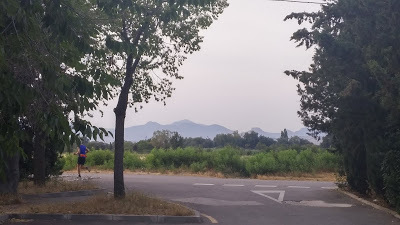 Pyrenees foothills and one of many runners we saw in the area. In these cantigas, there's a preponderance of candles and wax that could be used to make them. This Virgin also has a special talent for reviving children, so it's little wonder she enjoyed such wide-reaching devotion. The other miracle cures are likely bandwagon worshipers, who had no children or hadn't lost any but wanted to be in contact with this powerful Mary, anyway.
Pyrenees foothills and one of many runners we saw in the area. In these cantigas, there's a preponderance of candles and wax that could be used to make them. This Virgin also has a special talent for reviving children, so it's little wonder she enjoyed such wide-reaching devotion. The other miracle cures are likely bandwagon worshipers, who had no children or hadn't lost any but wanted to be in contact with this powerful Mary, anyway. 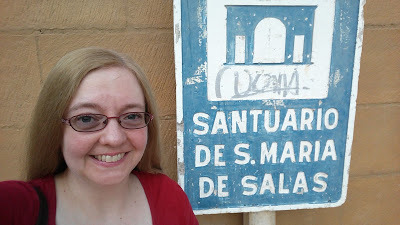 I had to content myself with an antique sign selfie because the miraculous
I had to content myself with an antique sign selfie because the miraculous image was locked up tight. When we visited the site, there was a plaque showing a pilgrimage route from France to Santiago de Compostela that went through Santa Maria de Salas, making the church an obligatory visit for any pilgrim--if it's ever open. Unlike the Villasirga cantigas, none of the Salas miracles mention Santiago. I can think of two good reasons. First, Salas is right on a Santiago pilgrimage route, while Villasirga is a bit off the direct path. Villasirga had to do publicity to draw in pilgrims, but Salas had a steady stream with no additional propaganda necessary. Second, the Cantigas are the product of the court of Alfonso X, el Sabio, King of Castile and León and many other territories north and south, but not of Aragón, where Salas is located. Alfonso X was related by marriage to Aragonese royalty, but why bother to promote an area that wouldn't bring economic benefit directly to one's Crown? That old Castilian pragmatism at work.
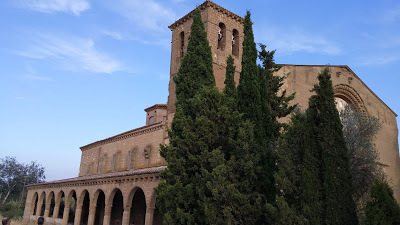 I discuss that pragmatism in
Law and Order in Medieval Spain
. This blog post seems like a good place to make the exciting announcement that my little Alfonsine book is being translated into Spanish! Soon, readers will be able to enjoy my love letter to Alfonso X in the language of Alfonso X. It's a very high honor indeed.
I discuss that pragmatism in
Law and Order in Medieval Spain
. This blog post seems like a good place to make the exciting announcement that my little Alfonsine book is being translated into Spanish! Soon, readers will be able to enjoy my love letter to Alfonso X in the language of Alfonso X. It's a very high honor indeed.Quisiera aprovechar este espacio alfonsí para anunciar que Law and Order in Medieval Spain se está traduciendo al español. Pronto, los lectores podrán disfrutar de mi carta de amor a Alfonso X en el idioma que él tanto ayudó a crear. Me siento muy honrada.
Published on July 20, 2019 09:45



